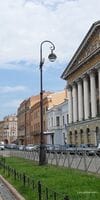The English Embankment is one of the embankments in the center of St. Petersburg, which stretches along the Neva River (2nd Admiralty Island).
English is one of the most famous and beautiful embankments of St. Petersburg, and is also one of the "parade" central Nevsky embankments of the city.
The formation of the English Embankment began in 1730, when the first wooden coastal fortifications were made.
Since 1762, the construction of solid stone embankments in St. Petersburg began.
Over time, the embankment became a prestigious place where rich people settled.

During its history, the embankment has had many names. Initially, the embankment was called the Lower Coastal Embankment, since it originated in the lower reaches of the Bolshaya Neva. Then the embankment was called Isaakievskaya, then Galernaya, and at the end of the 18th century - English, since mainly English subjects settled here, and later the English embassy and the English church were located here. Since 1919, the embankment has been called the Red Fleet Embankment, in honor of the revolutionary sailors who landed here to take part in the assault Winter Palace; at the same time, opposite the house No. 44, below the Blagoveshchensk Bridge, there was cruiser Aurora (now a museum ship), who made his historical shot from here to give a sign for the storming of the Winter Palace, this place is immortalized by a stele with an inscription about the event (located opposite the Rumyantsev mansion). In 1994, shortly before the arrival of the British Queen Elizabeth II in St. Petersburg, the name "English" was returned to the embankment.
The English Embankment is located on the left bank of the Neva River and stretches from the Senate Square to the New Admiralty Canal.
The length of the English embankment is 1306 meters.
The center of the embankment is a passing road, on both sides of which there are pedestrian sidewalks. On the north side, the embankment is open to the Neva River, and on the south side, historical buildings are lined up in almost unbroken rows.
Excursion tourist buses run along the embankment.
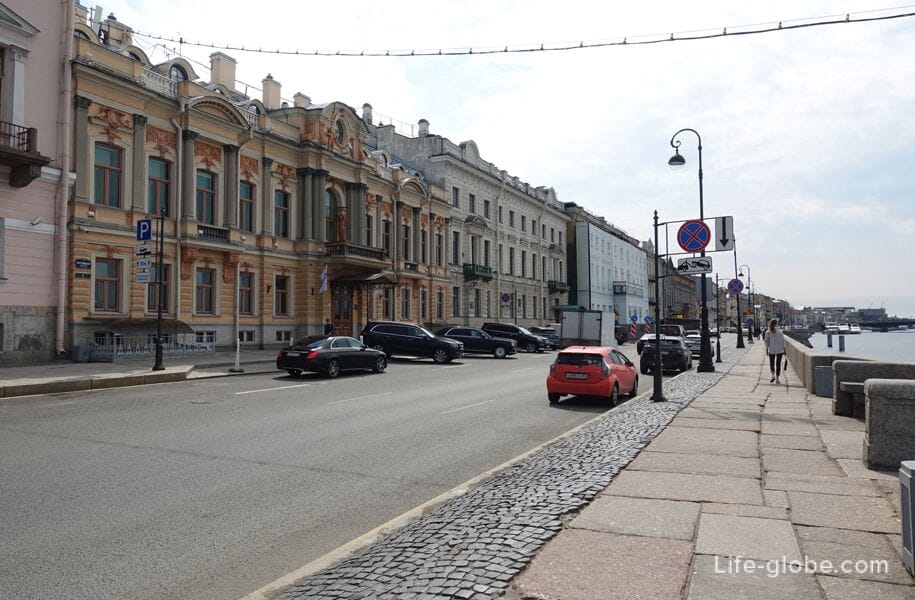
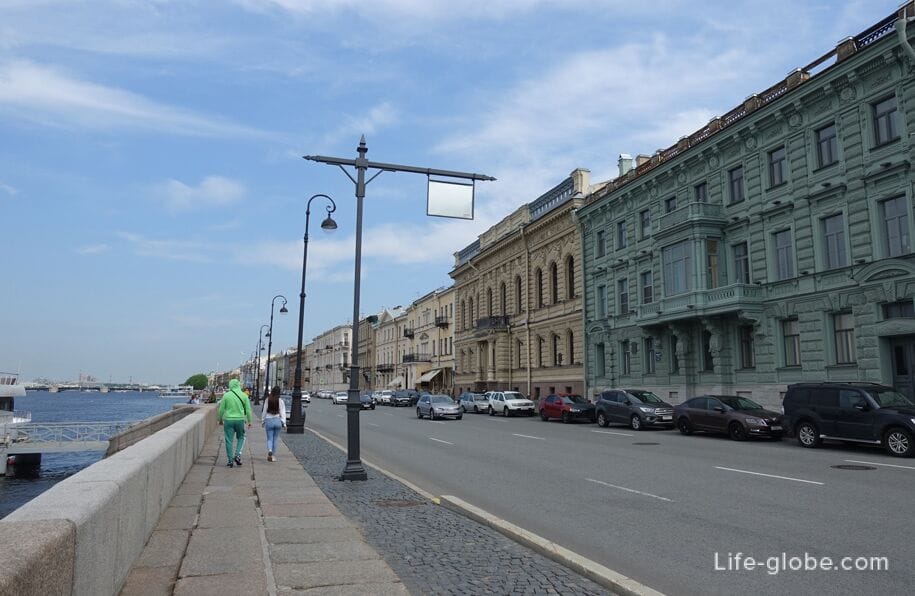
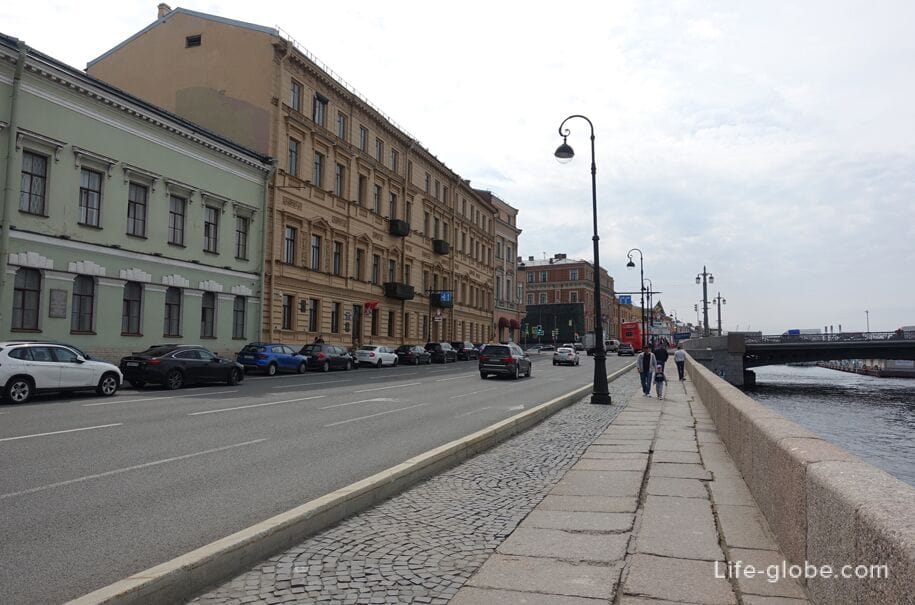
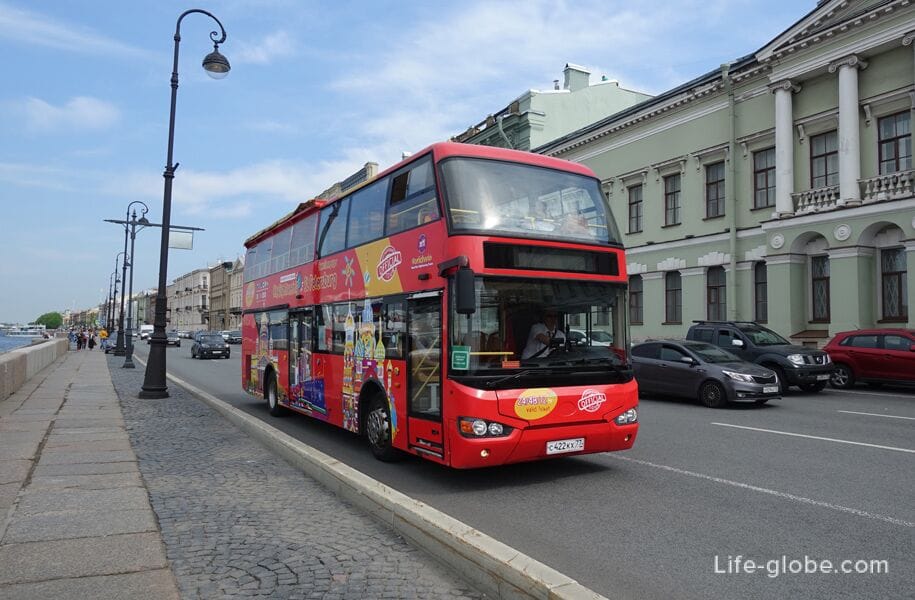
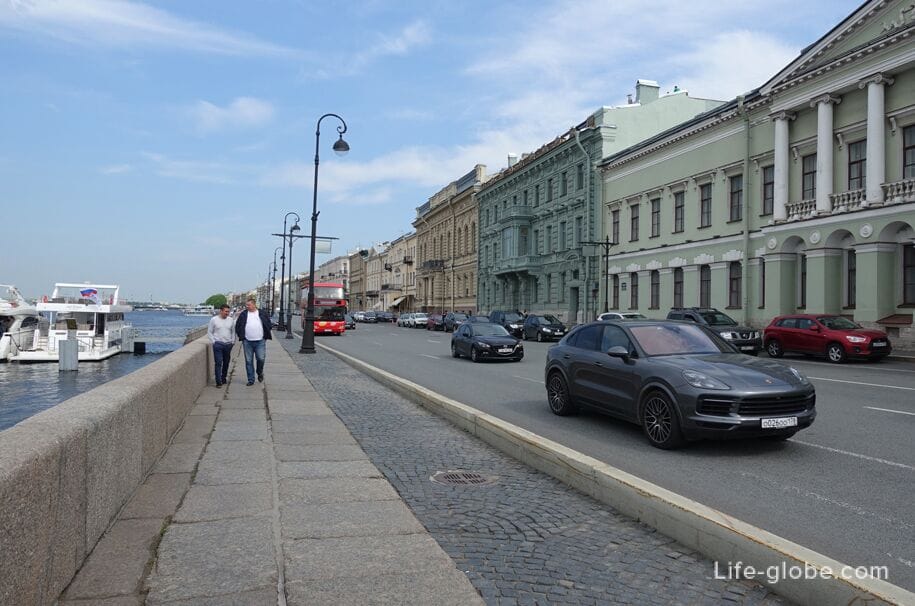
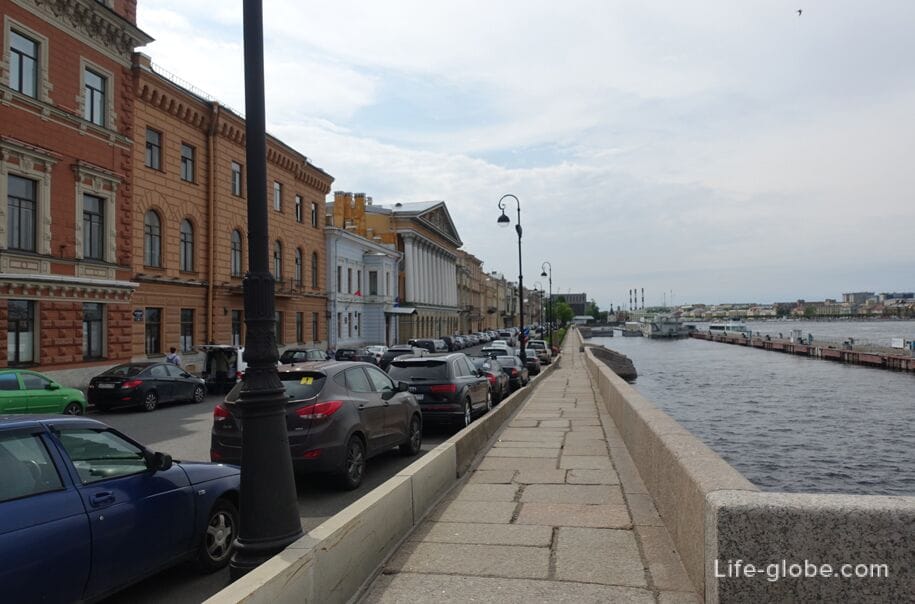
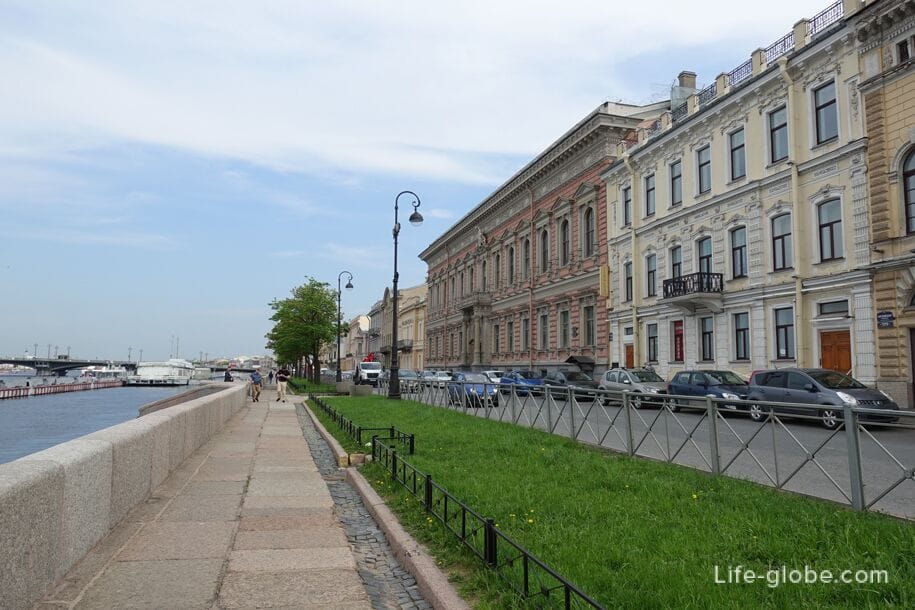
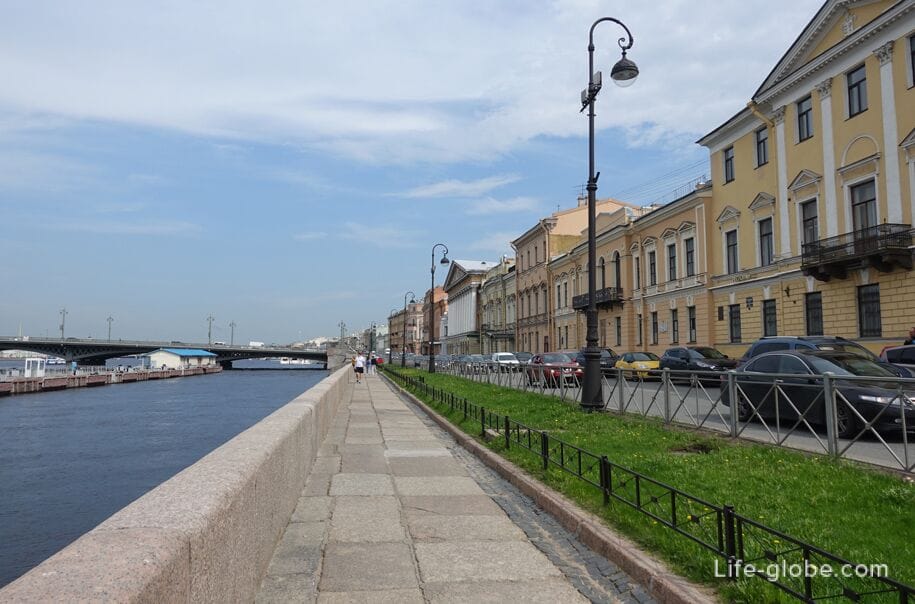
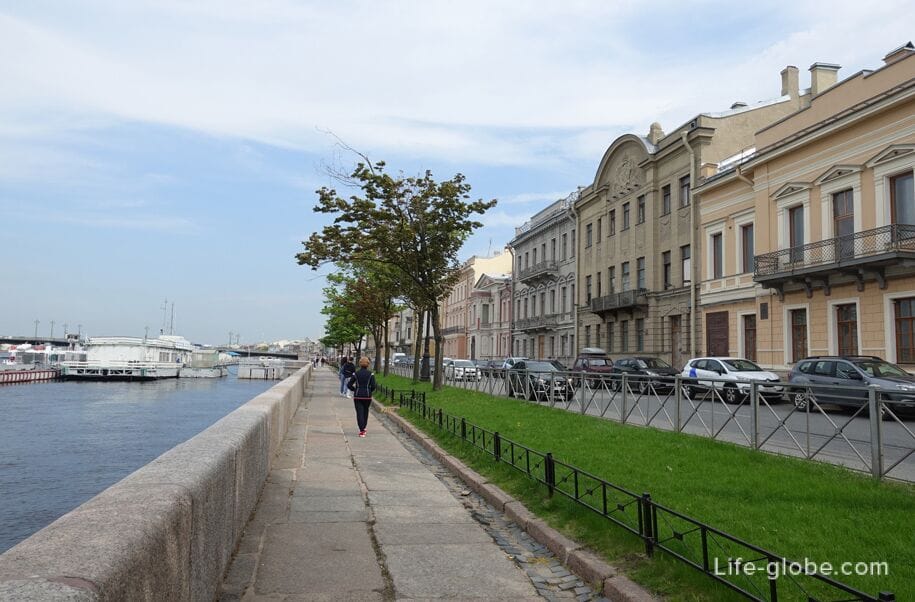
From the English embankment across the Neva River is thrown Blagoveshchensky Bridge, which connects the embankment (2nd Admiralty Island) with Vasilievsky Island.
The total length of the Blagoveshchensky Bridge is 349.8 meters, and its width is 38.7 meters. The bridge consists of 8 spans.
The bridge is a roadway and pedestrian, as well as a drawbridge. At the Blagoveshchensky Bridge, a central double-wing span is being built. Learn more about the Blagoveshchensk Bridge…

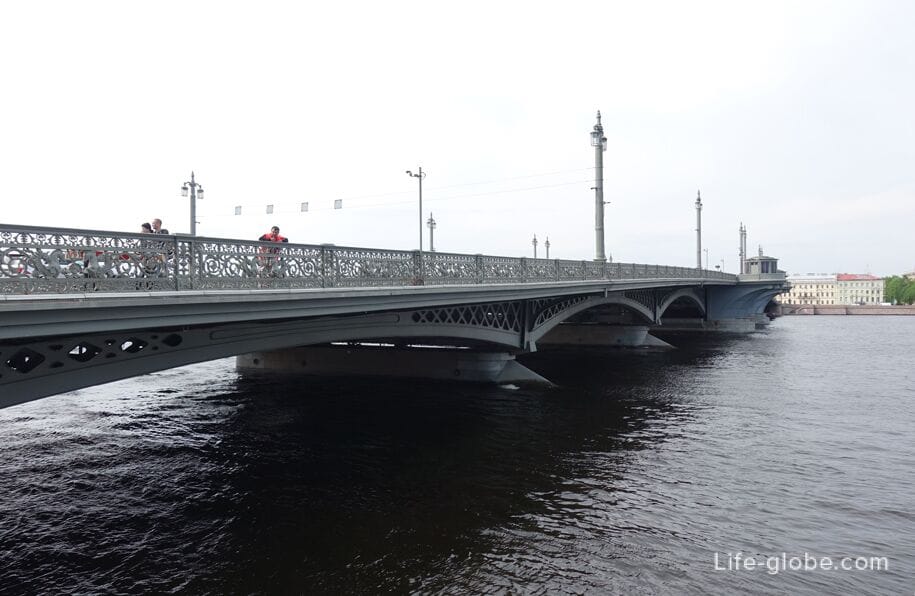
There are two pleasure craft berths on the English Embankment: the "Copper Horseman" (city pier) and the "Senate Pier".
The berths are also used for pleasure boats, on which during the navigation period you can make a water excursion along the rivers and canals of the city.
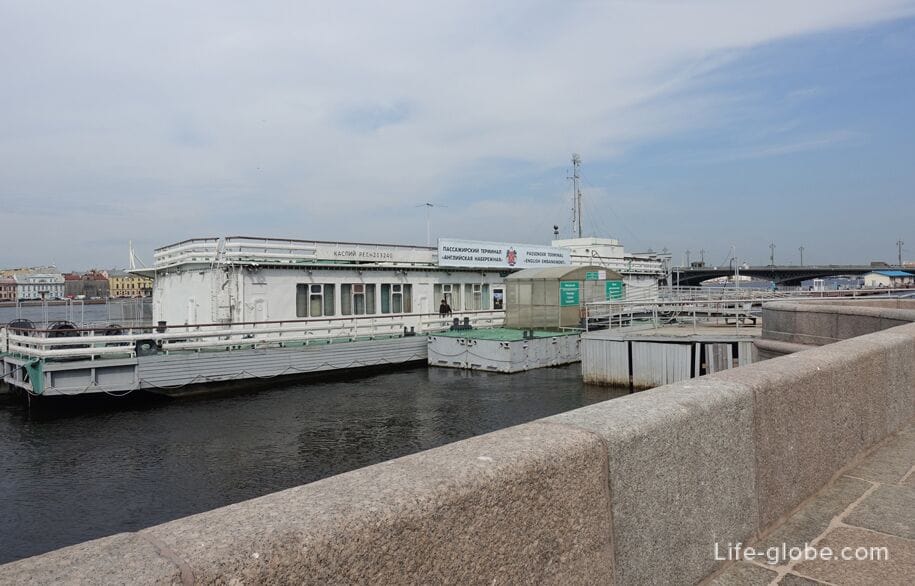
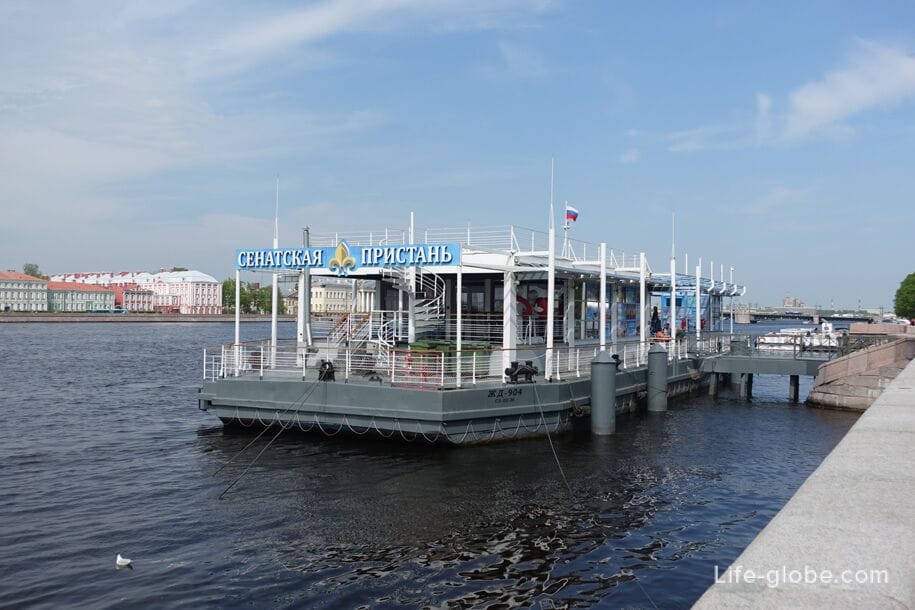
It is clearly visible from the English EmbankmentVasilievsky Island is the University Embankment and the Lieutenant Schmidt Embankment, along which, as well as along the English Embankment, there are beautiful historical buildings.
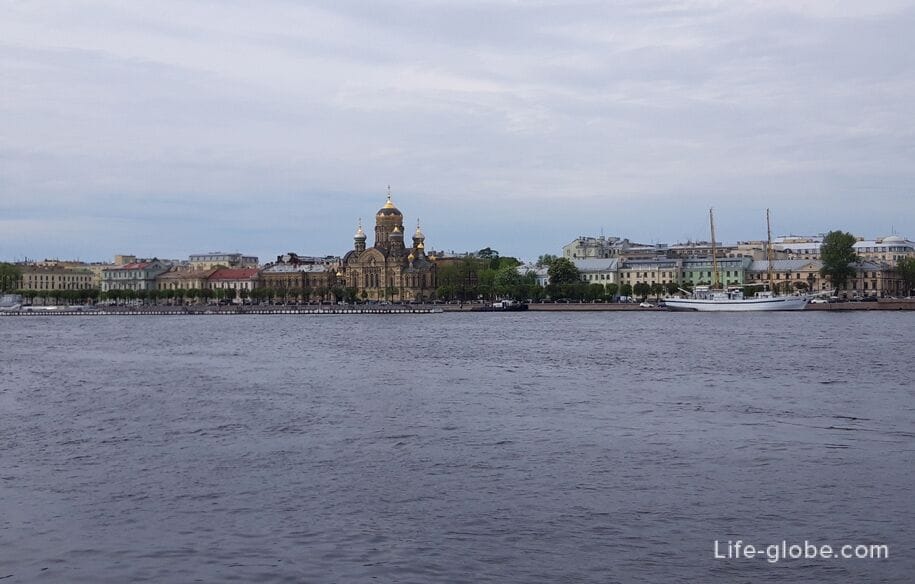
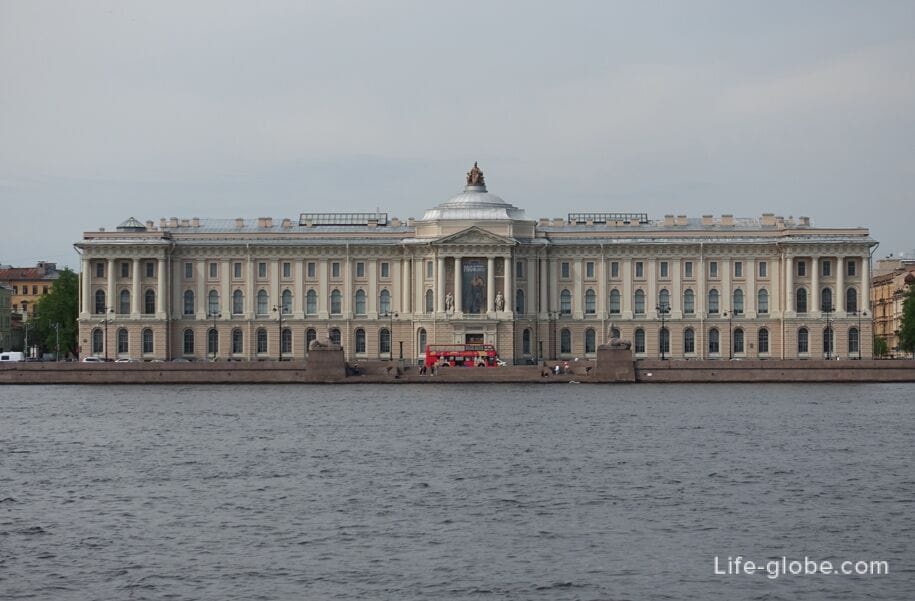
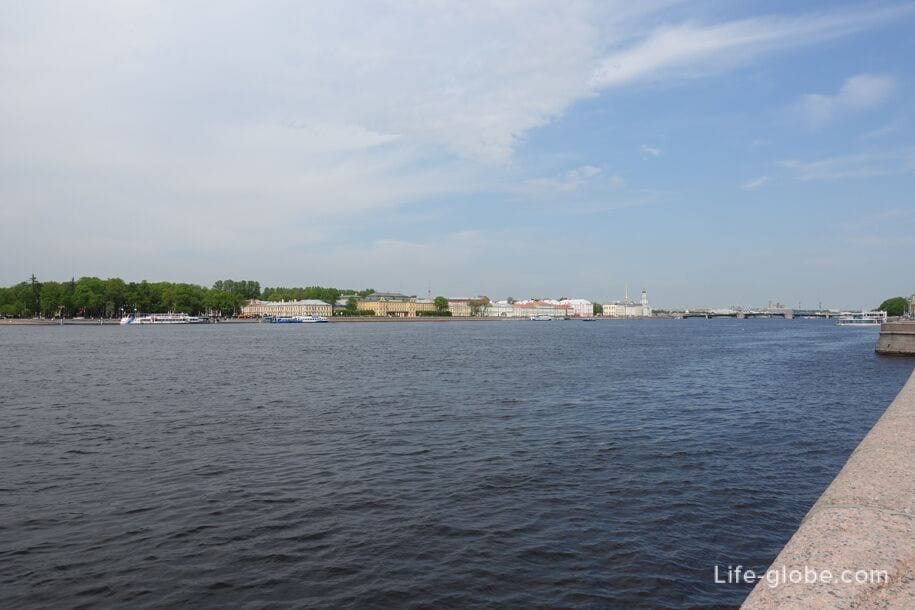
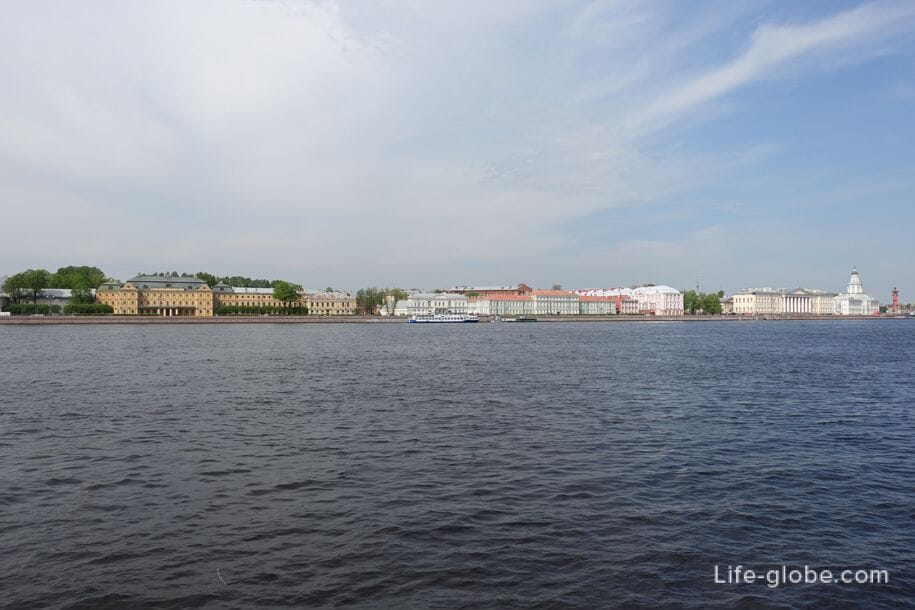
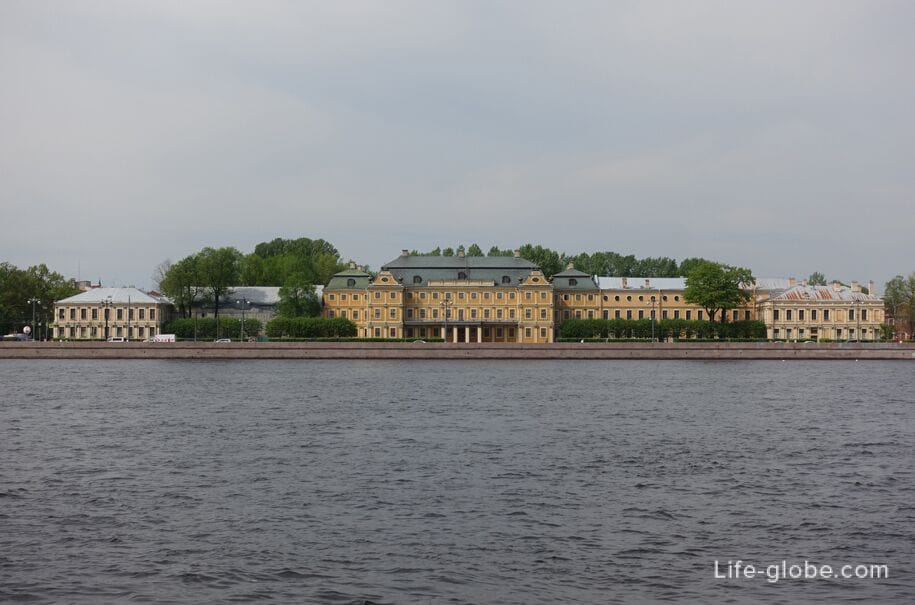
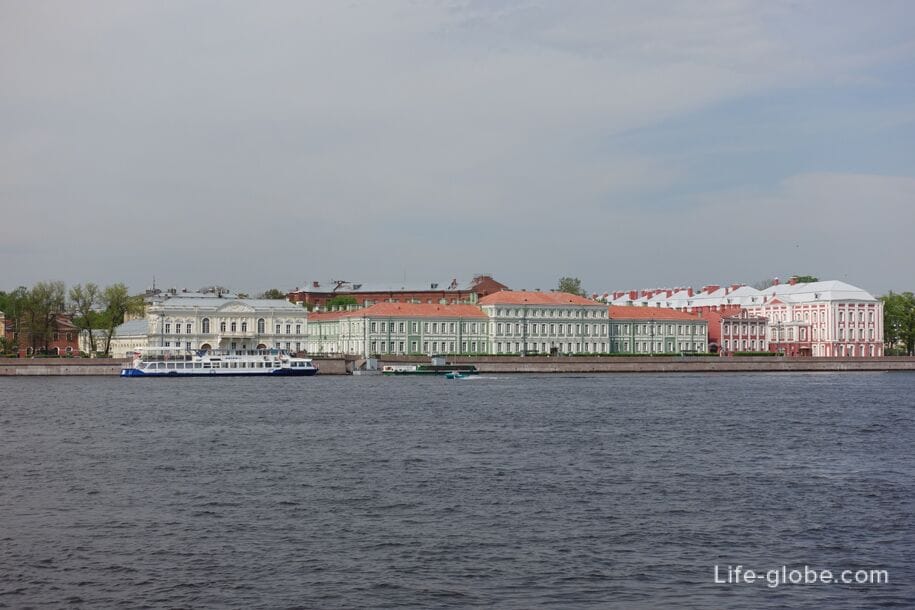
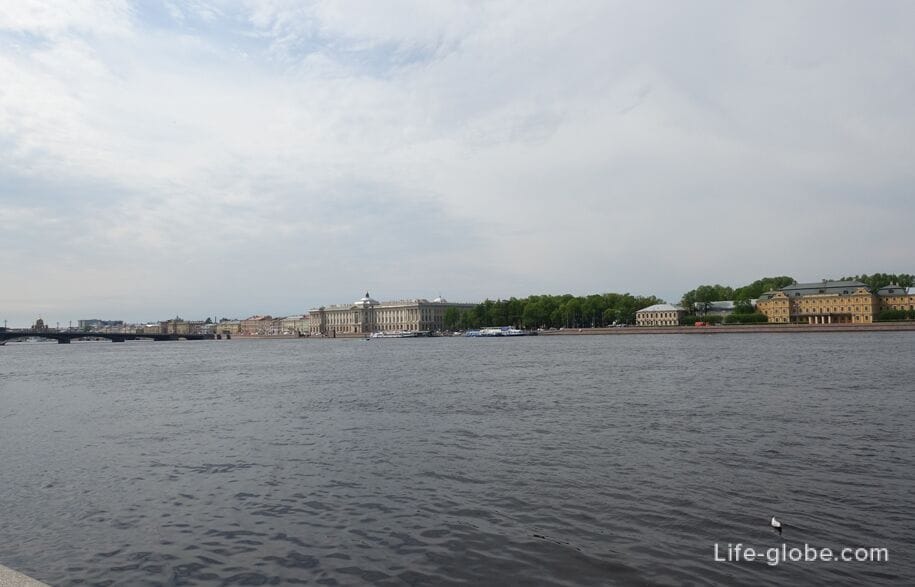
The English embankment begins just behind the spacious and wide The Senate Square, which, in a modern look, combines a park area and some of the main attractions of St. Petersburg.
The dominant feature of the square is the equestrian statue of Peter I "The Bronze Horseman", which was created on the initiative of Catherine II by the French sculptor Etienne Maurice Falcone.
Behind the Senate Square, the Alexander Garden, behind which you can see St. Isaac's Cathedral, on the open part of the colonnade of which there is a public circular observation deck, giving beautiful 360-degree panoramic views of the historical center of St. Petersburg.
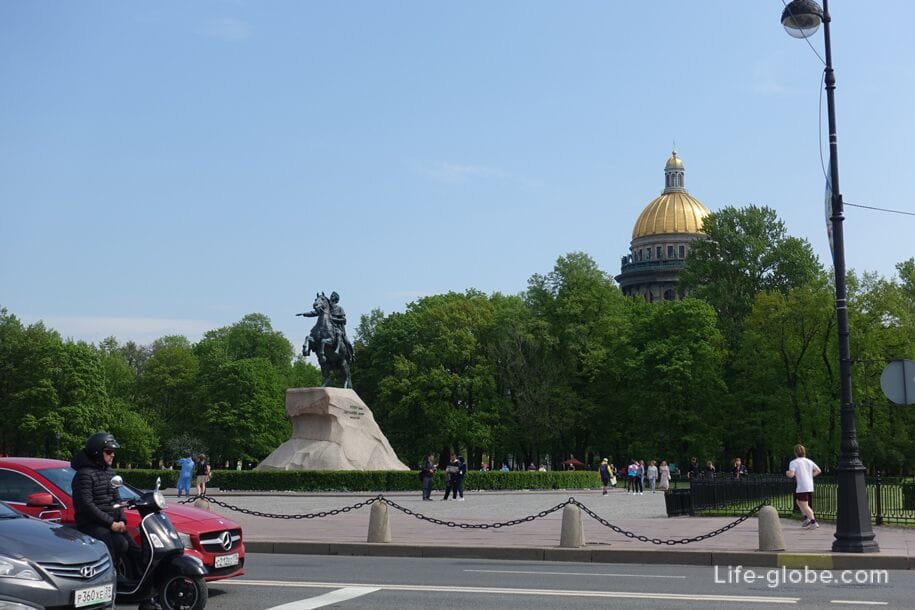
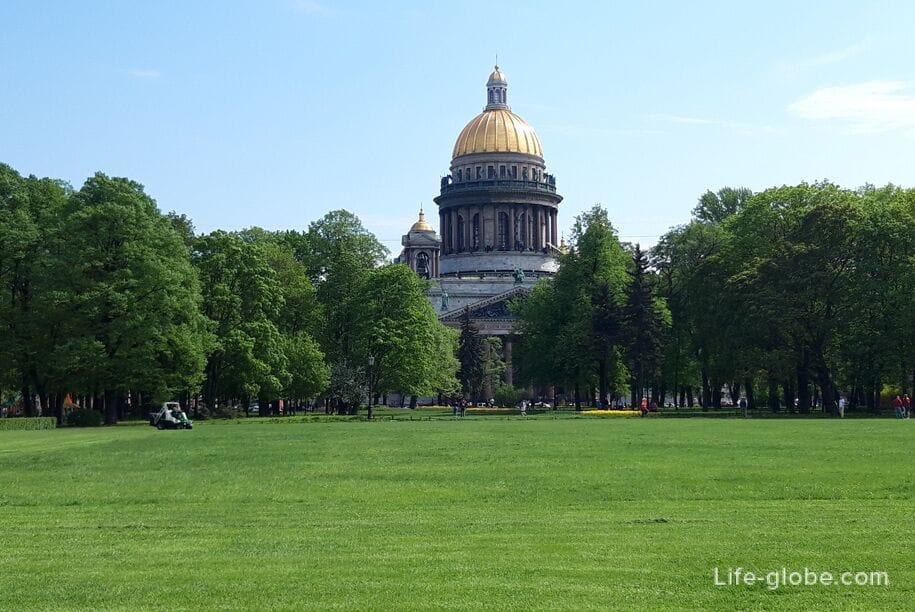
Buildings along the English Embankment
The buildings on the English Embankment are located close to each other and visually form a single solid facade, which has absorbed various architectural styles.
Such a close arrangement of houses in the past allowed saving valuable urban land.
Despite the diversity of the architectural ensemble and the height of the buildings, in general, they are all very harmoniously combined with each other.
During the history of the buildings on the English Embankment, they changed owners and were rebuilt. Today, residential apartments, offices, restaurants, shops , hotels, museums are located in restored historical buildings, there is also a theater, a wedding palace, a court, organizations, etc.
On the corner of the Senate Square and the English Embankment there are the buildings of the Senate and the Synod, which today are an architectural ensemble of historical buildings in the style of late classicism.
The main divisions of the Constitutional Court of the Russian Federation are located in one wing of the building. In the other (the former building of the Synod) - the Presidential Library named after B. N. Yeltsin. Learn more about the Senate and Synod buildings…

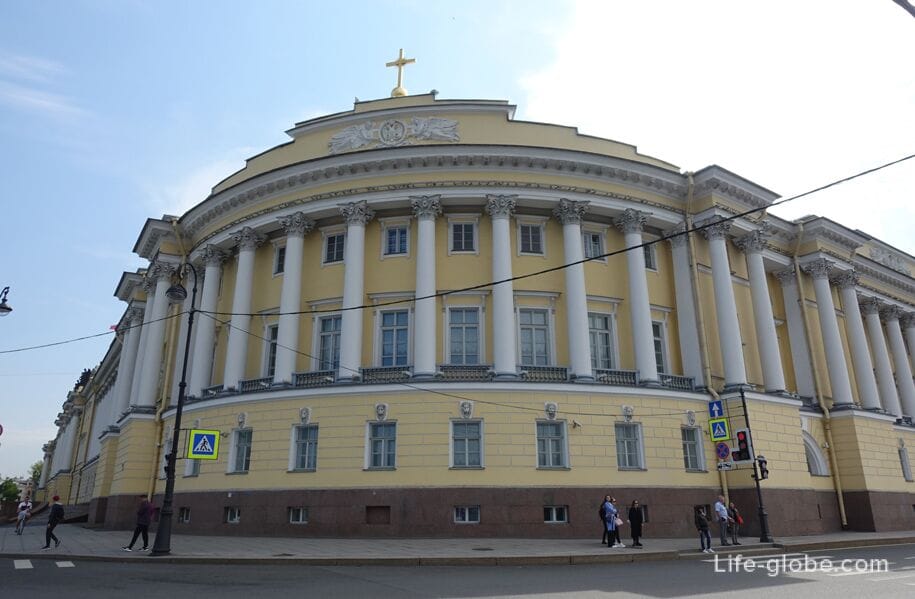
English embankment 4 - the house of Countess A. G. Laval.
The style of the building is classicism.
The main facade of the building is decorated with a colonnade of 10 Ionic columns. The windows of the side wings are decorated with triangular pediments-sandricks, above which there are sculptural panels on mythological themes.
Today, the building houses the court.
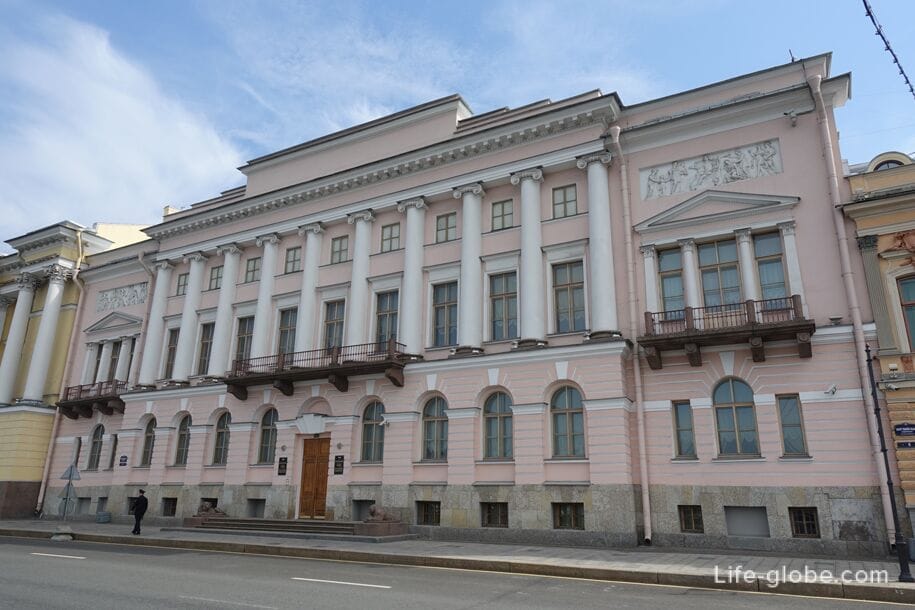
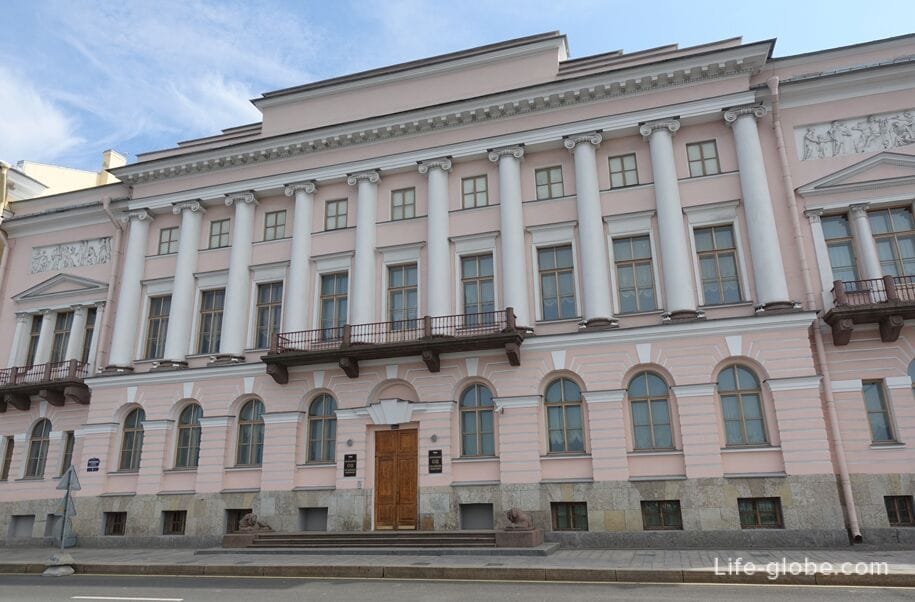
Angliyskaya Embankment 6 - the house of E.P. Kazalet / the mansion of Vyacheslav Nikolaevich and Maria Klavdievna Tenishev.
The style of the building is neo-Baroque.
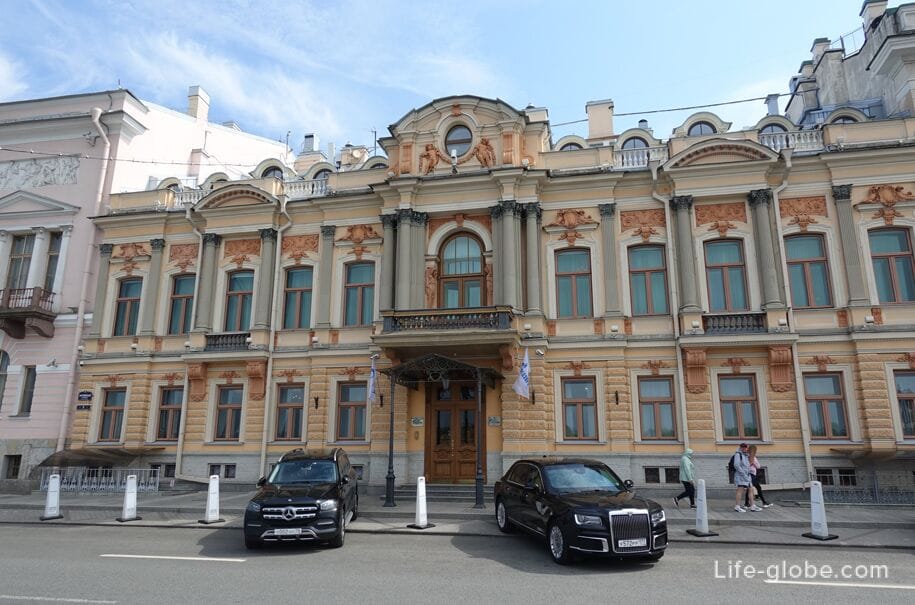
English embankment 8 - the mansion of I.F. Paskevich.
The mansion was built in the first third of the 18th century and rebuilt in 1856-1857 by architects A.H. Pel and R.A. Gedike.
The style of the building is eclectic.
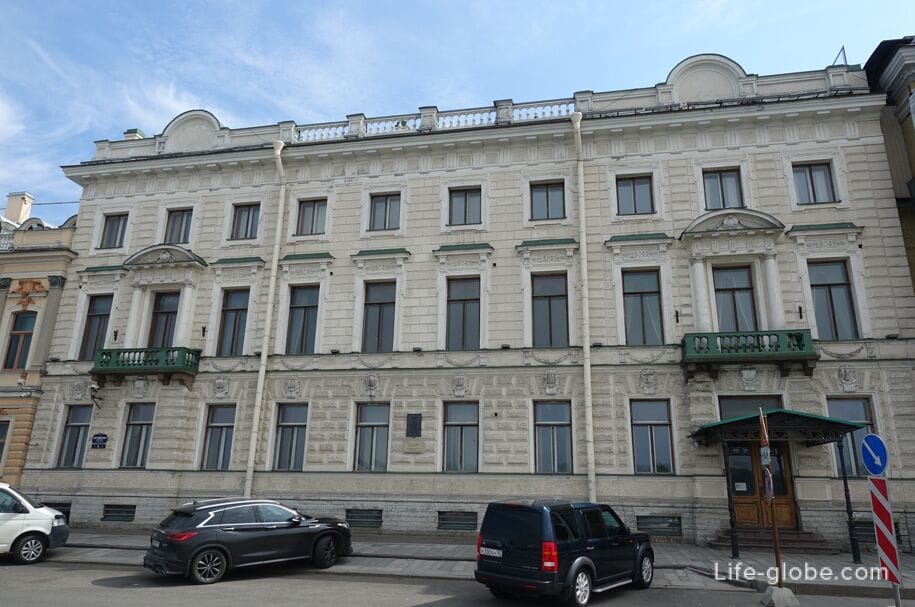
Angliyskaya Embankment 10 - A.L. Naryshkin's mansion / Vorontsov-Dashkov house.
The house was built in 1736-1738 for A.L. Naryshkin, since 1812 it belonged to Count A.I. Osterman-Tolstoy, and from 1867 to 1917 - Vorontsov-Dashkov.
The style of the building is classicism.
The strict facade of the building is decorated only with a porch-entrance.
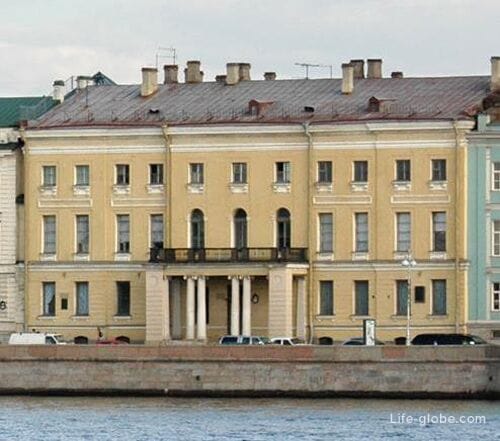
The English embankment 12 is the house of the merchant M. Markevich, built for him in 1845 by the architect Hieronymus Corsini.
At the beginning of the 20th century, the owner of the building was Lazar Polyakov.
The style of the building is eclectic.
The building is decorated with pilasters placed in each tier, which is typical of the Italian Renaissance.
The building houses the Consulate General of the Netherlands.
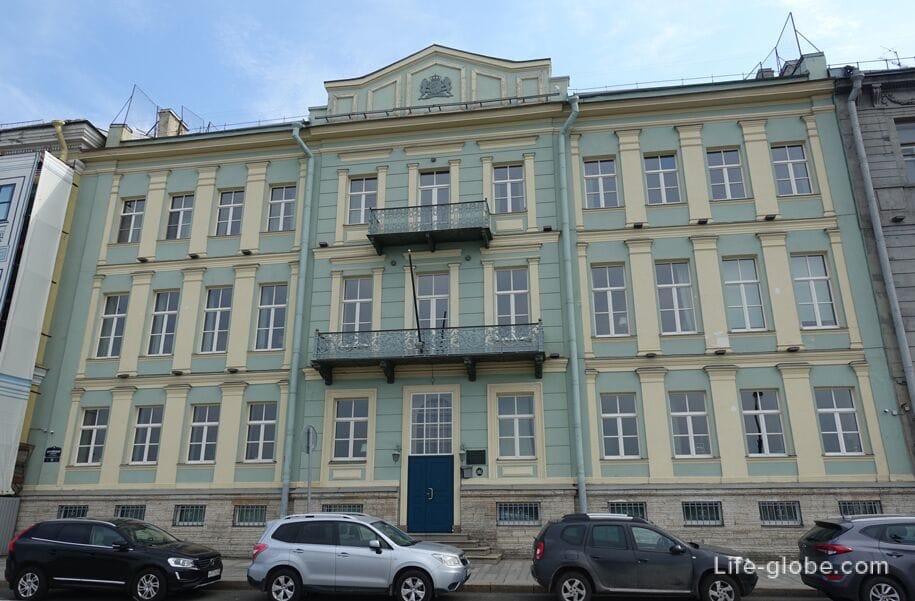
Angliyskaya Embankment 14 -the Tenishevs' house / the mansion of M.K. Chaplits.
The building was built in the first third of the 18th century, rebuilt in 1870 by architect V.F. Esterreich and in 1909 by architect S.Y. Kraskovsky.
The style of the building is neoclassicism.
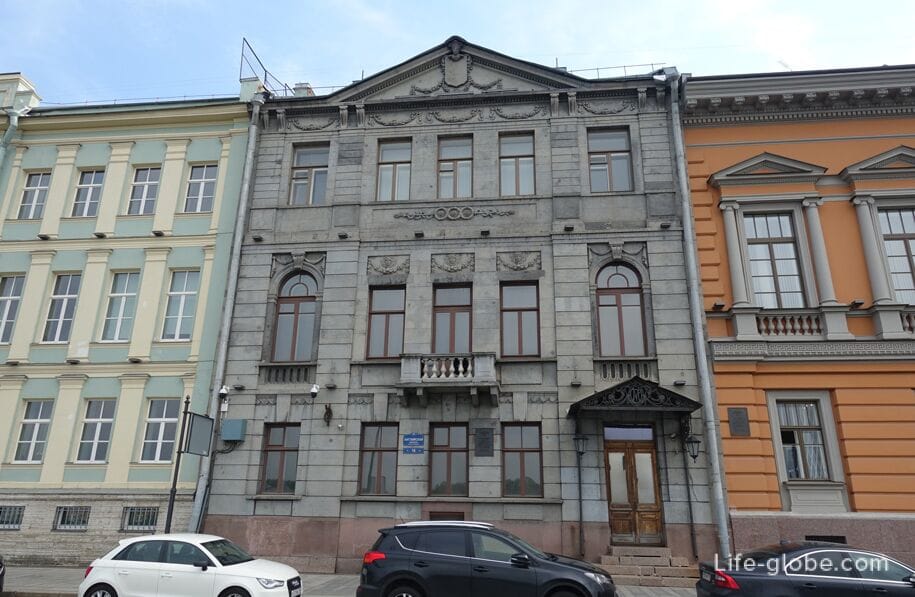
English embankment 16 - the mansion of P.P. Durnovo.
The building was built in the first third of the 18th century and rebuilt in 1837 by the architect A.A. Mikhailov, and in 1872 by the architect L.F. Fontana.
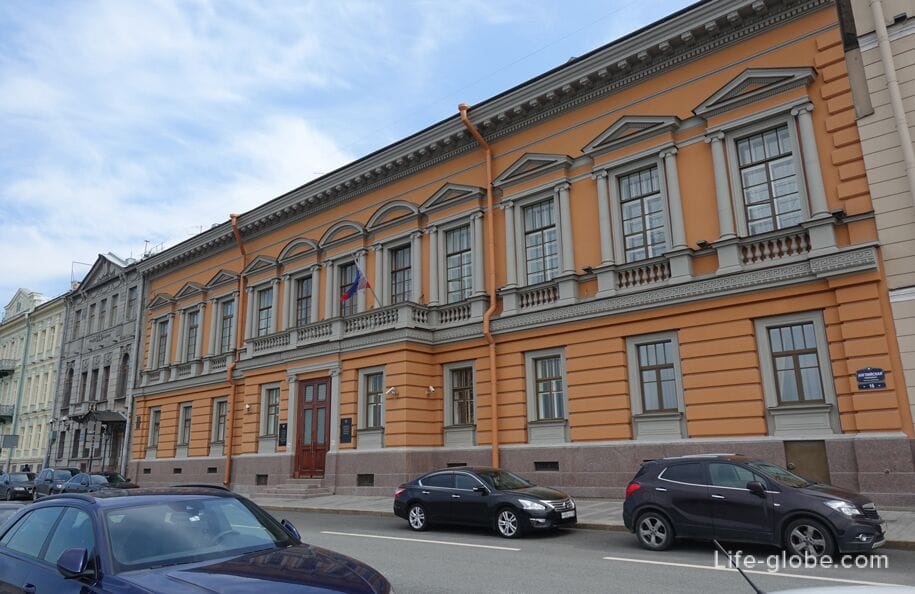
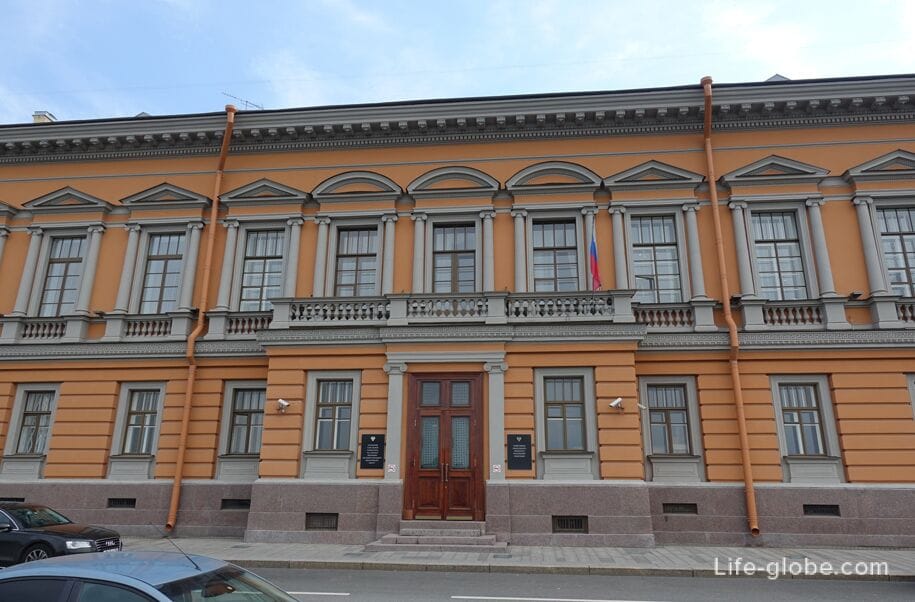
Angliyskaya Embankment 18 - the house of A. Lobanov-Rostovsky / the house of the merchant of the 1st guild D.I. von Gardera and his heirs until 1872. In 1872-1904 - the own house of the St. Petersburg private commercial Bank.
The building has a very simple facade and stands out only with two balconies and rusticated blades.
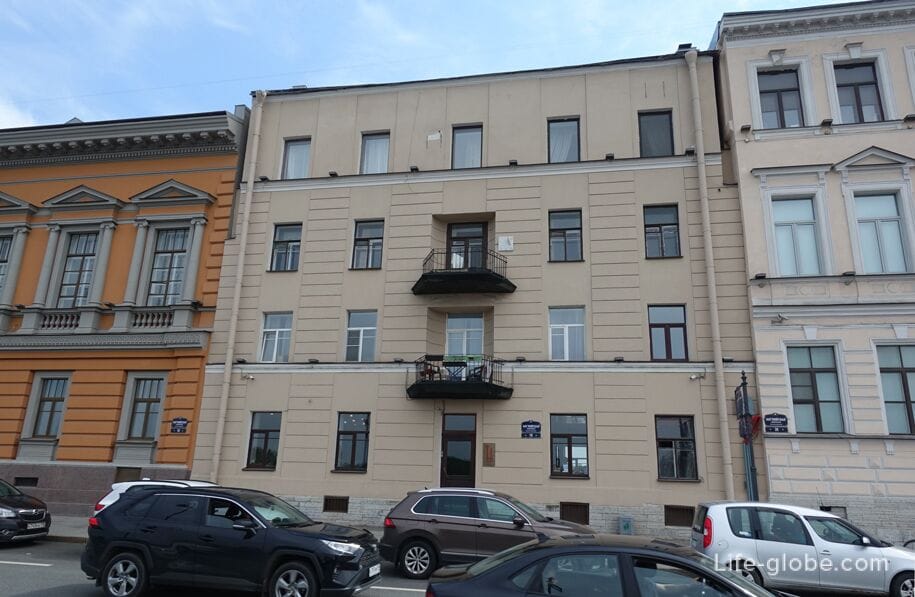
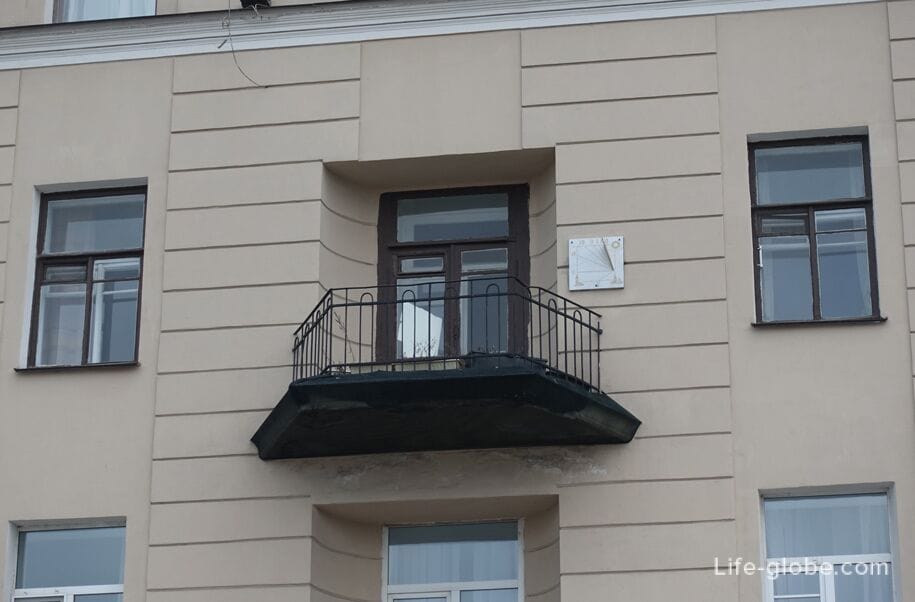
Angliyskaya Embankment 20 - the mansion of V.P. Orlov-Davydov, which was presented to Count Alexey Orlov by Empress Catherine II.
The building is angular: English Embankment / Zamyatin Lane.
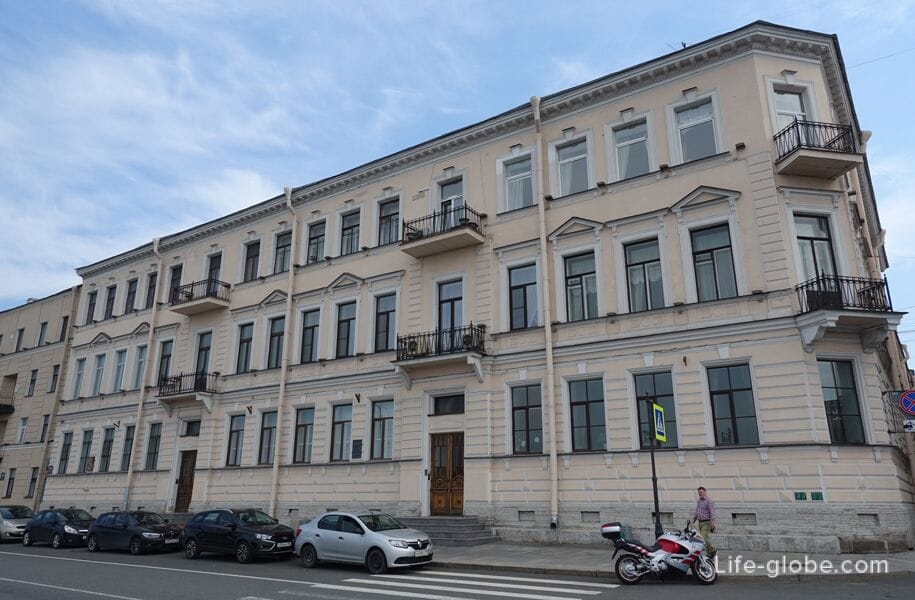
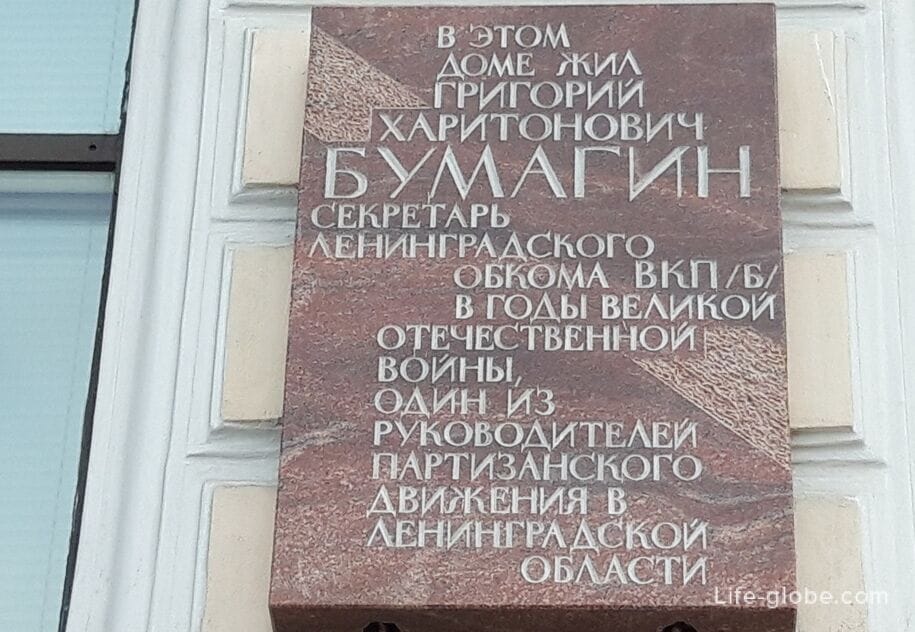
Englishskaya Embankment 22 - S.P. Gorstkin's house / N.V. Tolstoy's apartment house / Duke G.N. Leuchtenberg's mansion.
The building is angular: English Embankment / Zamyatin Lane.
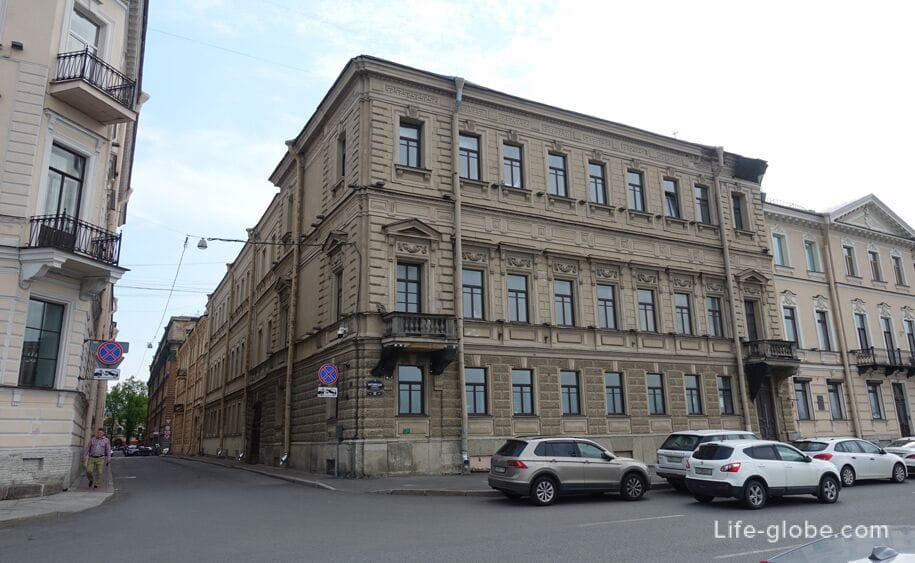
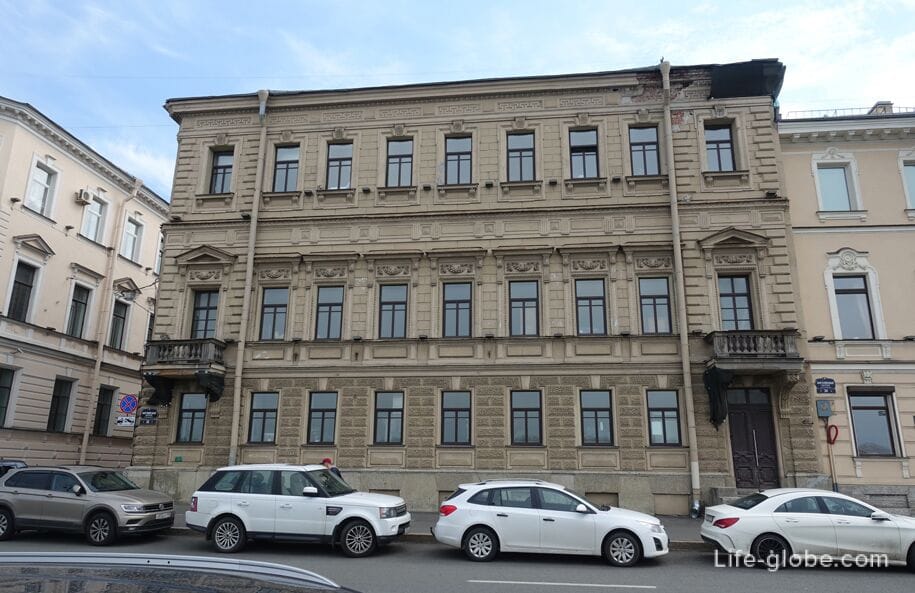
English embankment 24 - house of N.A. Kondoidi (Olsufyeva) / house of O.N. Vargunina / house of V.V. Skarzhinsky.
The style of the building is classicism.
The first floor of the house is rusticated, the top two are smooth. The risalit is completed with a triangular pediment and is marked by a wide balcony at the level of the second floor.
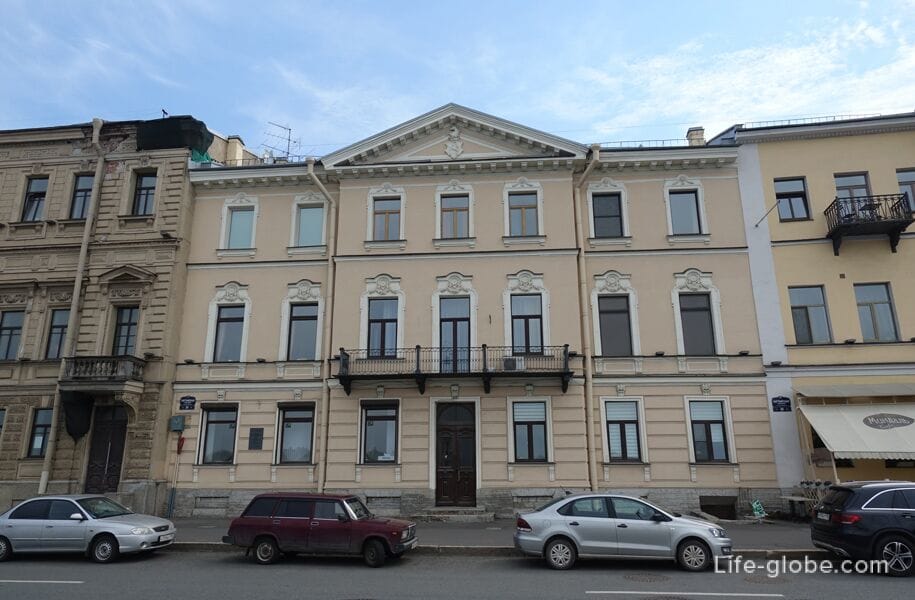
English embankment 26 - Yusupov house / Chelyshev house.
The house was built in the first third of the 18th century and rebuilt in the 1835s by the architect A.I. Melnikov.
The building is distinguished by a wide balcony on the second floor level, located on the protruding central entrance part of the building.
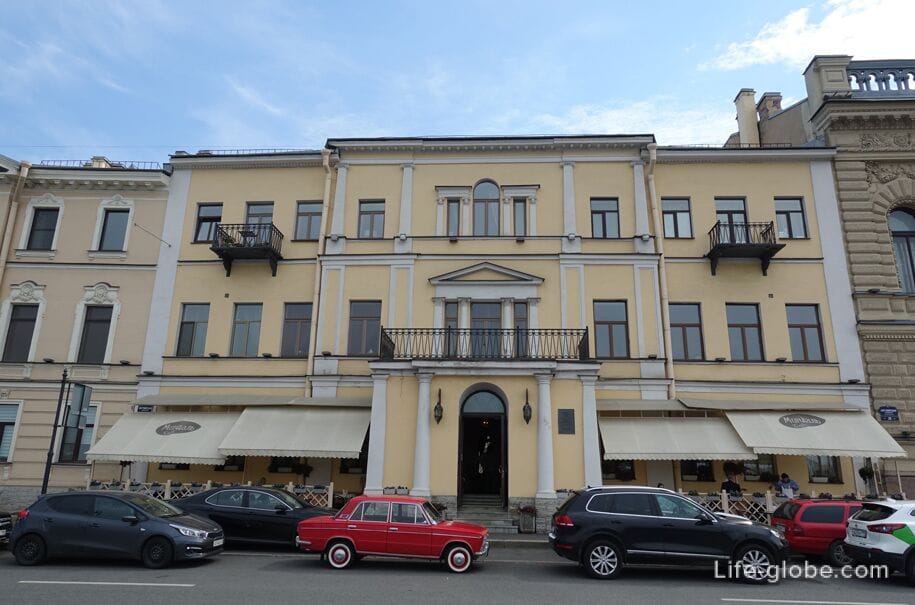
English embankment 28 - the mansion of P.P. von Dervizov (the Wedding Palace).
The 18th-century building was rebuilt in 1889-1890 by the architect A.F. Krasovsky. In 1904-1917, it was the palace of Grand Duke Andrey Vladimirovich. Now it is the wedding palace.
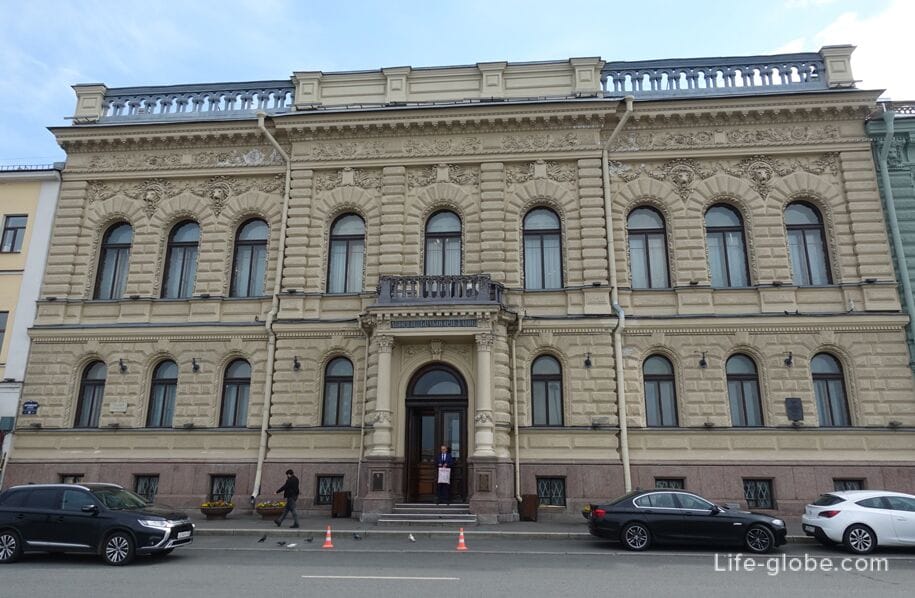
English Embankment 30 - the mansion of the Bavarian Consul General E.M. Meyer.
The building was built in 1720-1740 and rebuilt in 1869-1871 by architects R.B. Bernhard and K.K. Rahau.
The style of the building is eclectic.
In the spans between the windows of the building there are women's heads in winged helmets and two bowed men's heads with long forked beards. The house is also distinguished by balconies, including a glazed central one.
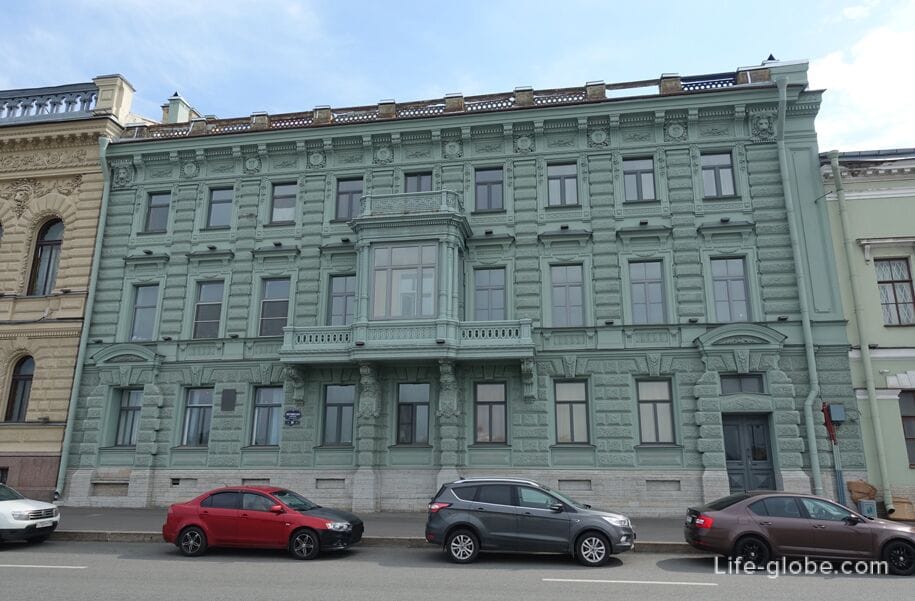
32 Angliyskaya Embankment - the house of the Board of Foreign Affairs.
The building was built in the 1750s-1760s for Prince B.A. Kurakin and rebuilt in 1782-1783 by architect D. Quarenghi for the College of Foreign Affairs. In 1802-1832, the Ministry of Foreign Affairs was located in the building, in 1832-1855 the Imperial Military Academy was located, and in 1855-1904 the Academy of the General Staff was located.
The style of the building is classicism.
The facade of the building is decorated with an eight-column portico with a pediment.
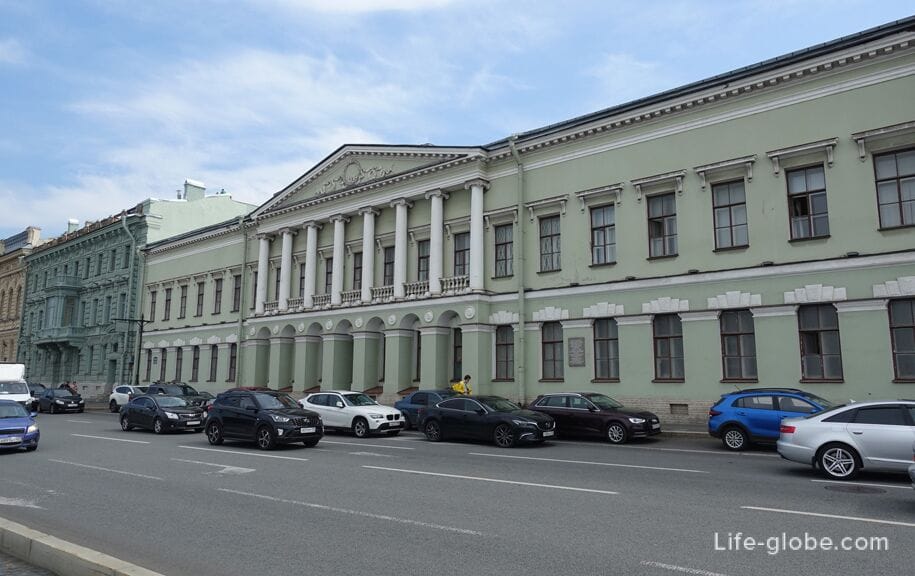
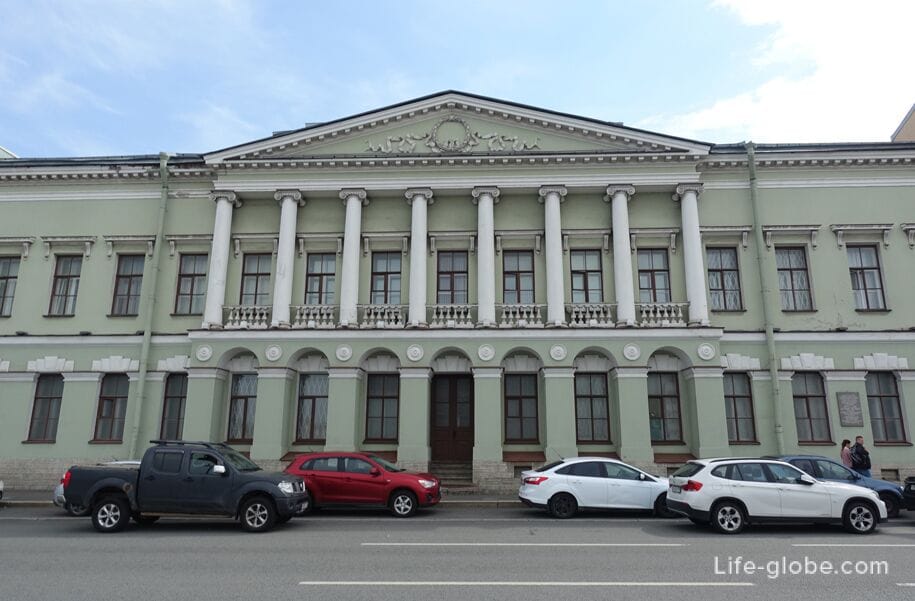

34 Angliyskaya Embankment - the mansion of S.P. von Derviz.
During the history of the house, it was divided into two mansions.
Today, the building houses the State Chamber Music Theater "St. Petersburg Opera", which also conducts excursions. Entrance from Galernaya Street, 35. Website of the theater: spbopera.
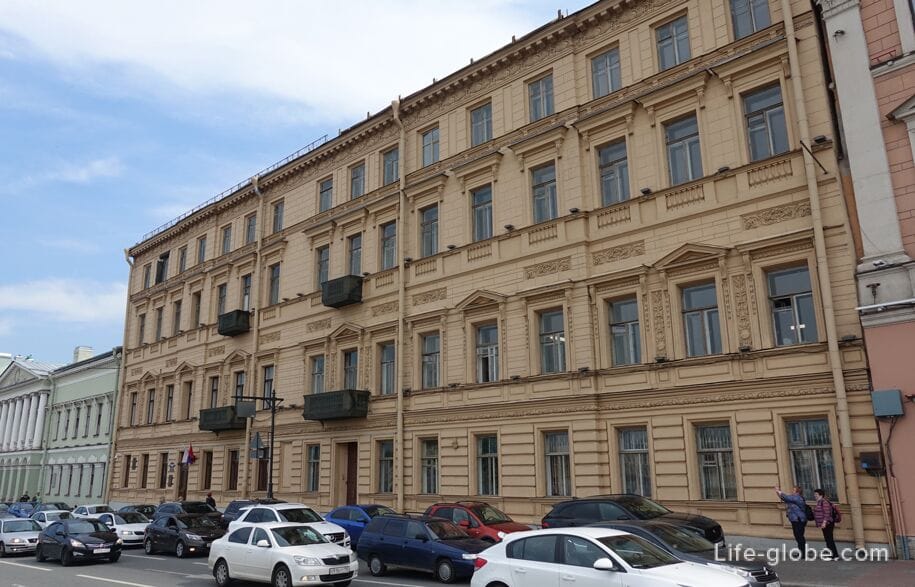
Angliyskaya Embankment 36-the apartment house of V.A. Vonlyarlyarsky.
The style of the building is eclectic.
The entrance arcade and the side bay window are decorated with caryatids. The caryatids of the lower tier have necklaces on their necks.
The building is angular: English Embankment / Labor Square. The extended facade of the house overlooks the Labor Square.
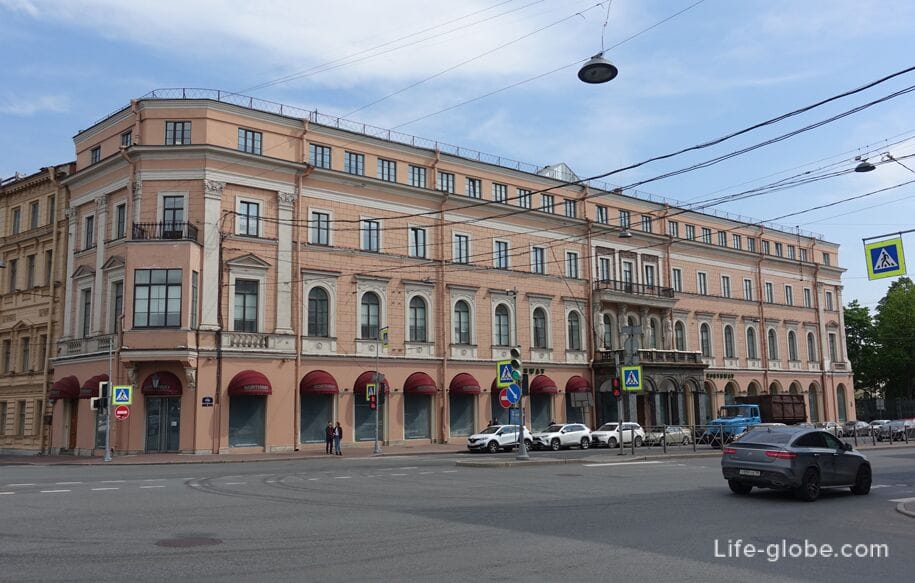
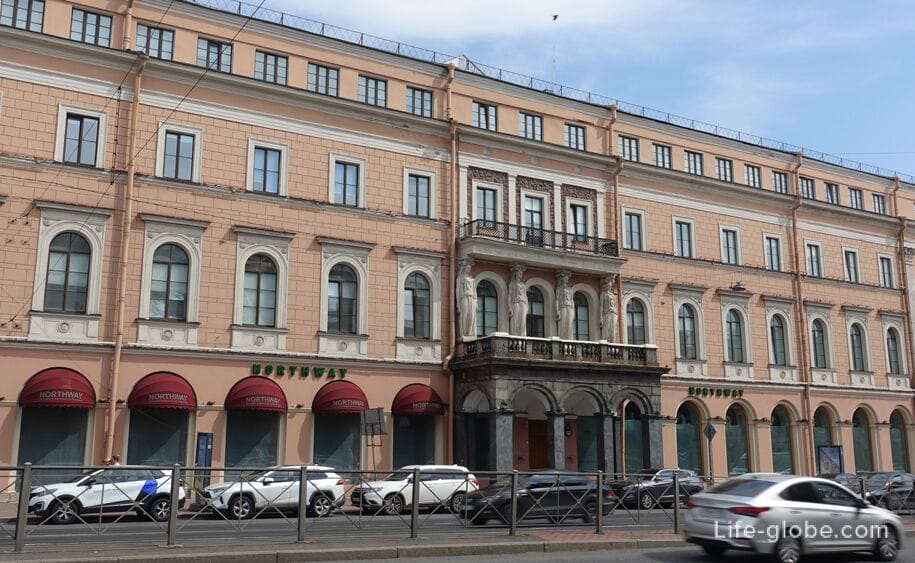
English embankment 38 - the apartment house of A.F. Clark.
The building was built at the end of the 18th century and rebuilt in 1883 and 1889-1890 by the architect V.A. Schroeter.
Today, the 51 Central Design and Technological Institute of Ship Repair, founded in 1954, is located within the walls of the building.
The building is angular: English Embankment / Labor Square.
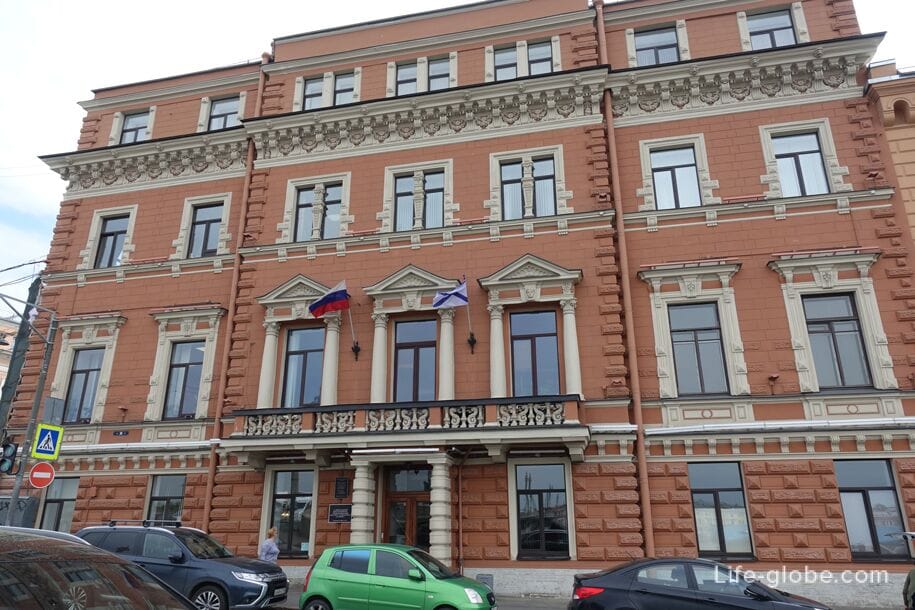
Angliyskaya Embankment 40-the mansion of A.I. Thomsen-Bonnard / the mansion of V.I. Astashev.
The style of the building is neo-Renaissance.
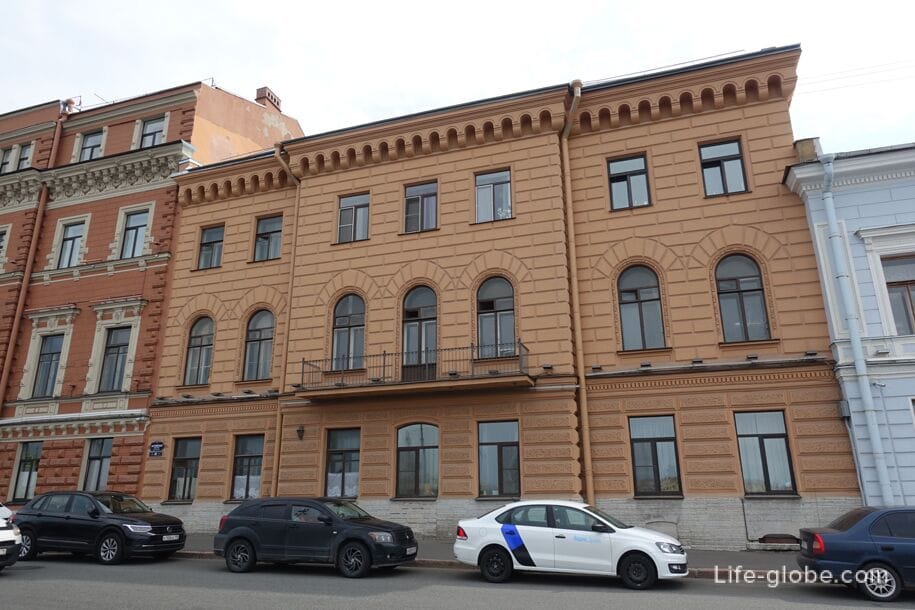
English embankment 42 - the mansion of A.A. Yakovlev / the mansion of A.V. Polezhaev.
This small building is distinguished by a protruding central part, where there is a bay window at the second floor level, and the entrance is decorated with an openwork metal canopy.
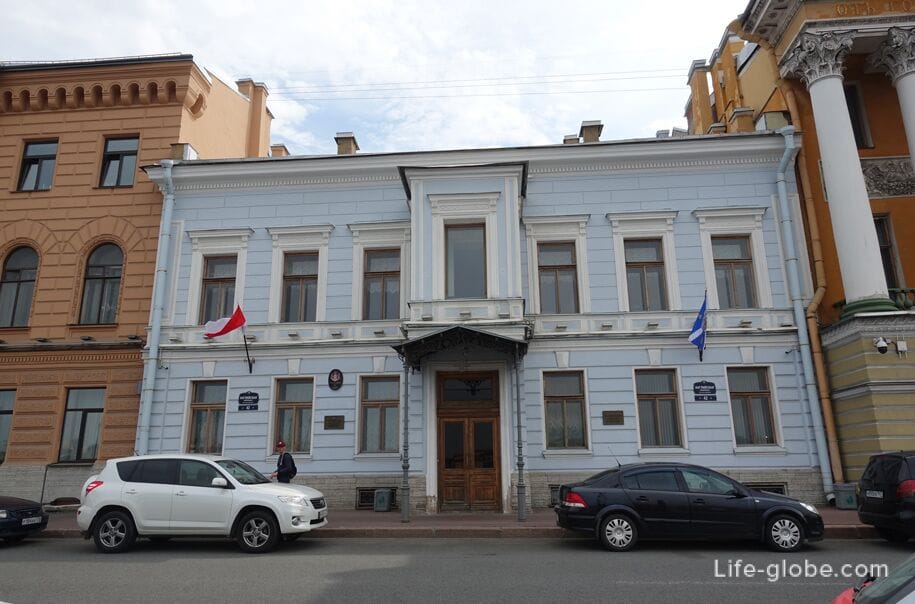
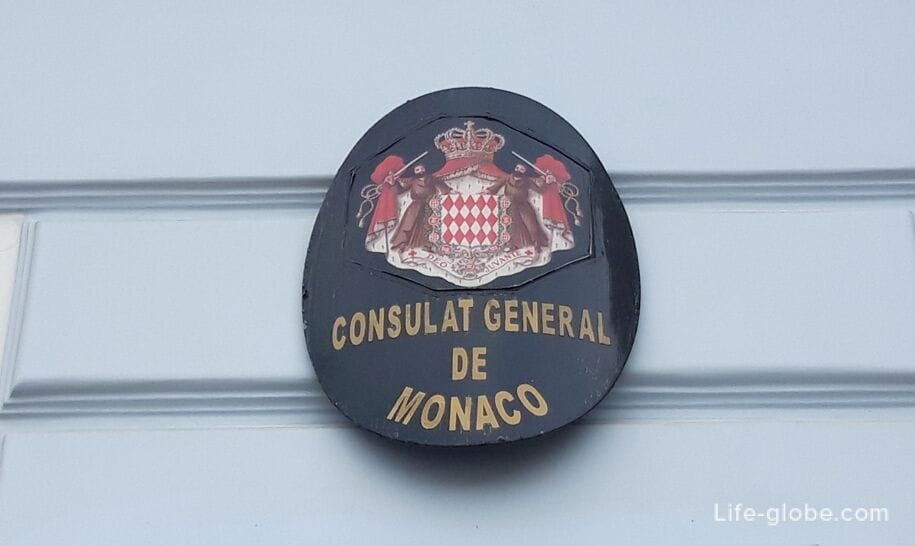
44 English Embankment - the mansion of Count N.P. Rumyantsev.
This is one of the most beautiful buildings on the English Embankment, which was one of the centers of the cultural life of St. Petersburg.
The style of the building is classicism.
Today, a museum with permanent exhibitions operates within the walls of the former mansion. There are excursions around the mansion, temporary exhibitions, seminars, festivals, lectures, events for children, etc. Read more about the Rumyantsev mansion and the museum…

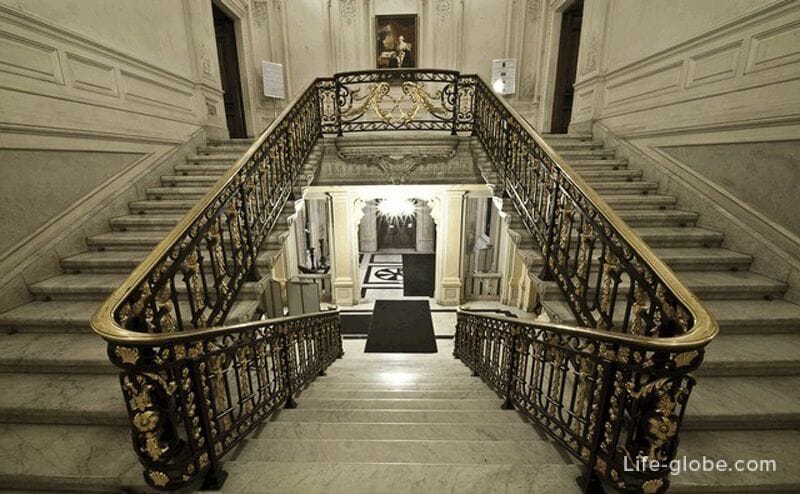
Angliyskaya Embankment 46-the mansion of E.M. Dolgorukova.
Today, this small, pretty house, an 18th-century manor house, houses the 2-star Park River Hotel with a cafe, free Wi-Fi, free parking and spacious rooms.
The rooms are equippedwith a TV, a coffee / tea maker and a private bathroom with a bath, a hairdryer and toiletries. Some rooms have a living room and a seating area.
Breakfast can be included in the room rate. Link to the hotel
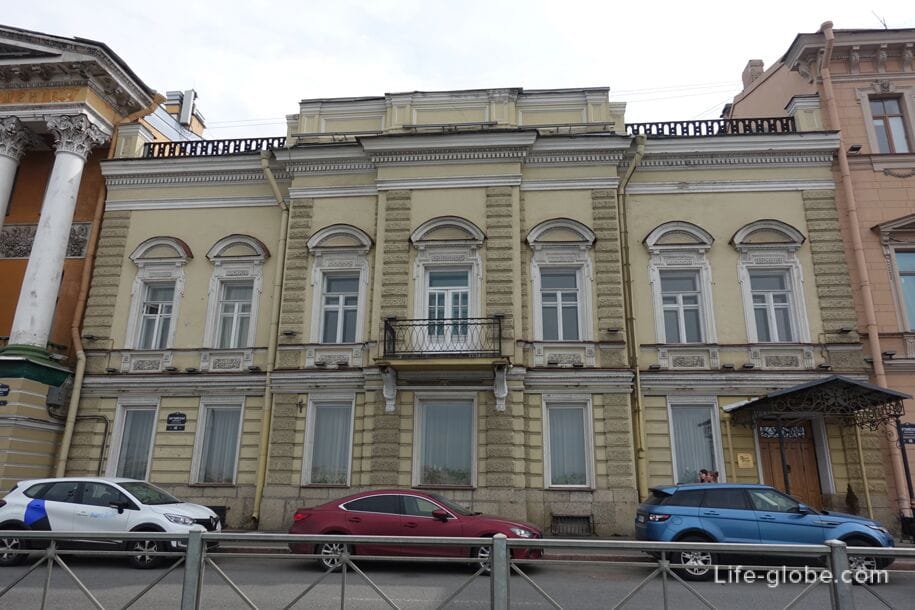
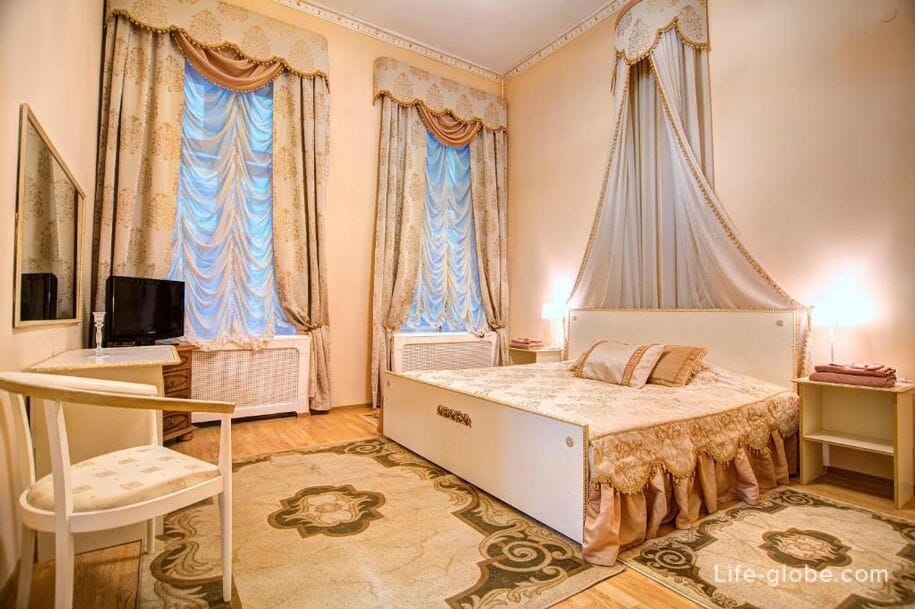
English embankment 48 - the mansion of P.K. Ferzen / A.Ya. Prozorov.
The building was built in the first third of the 18th century and rebuilt in 1838 by the architect P.S. Sadovnikov.
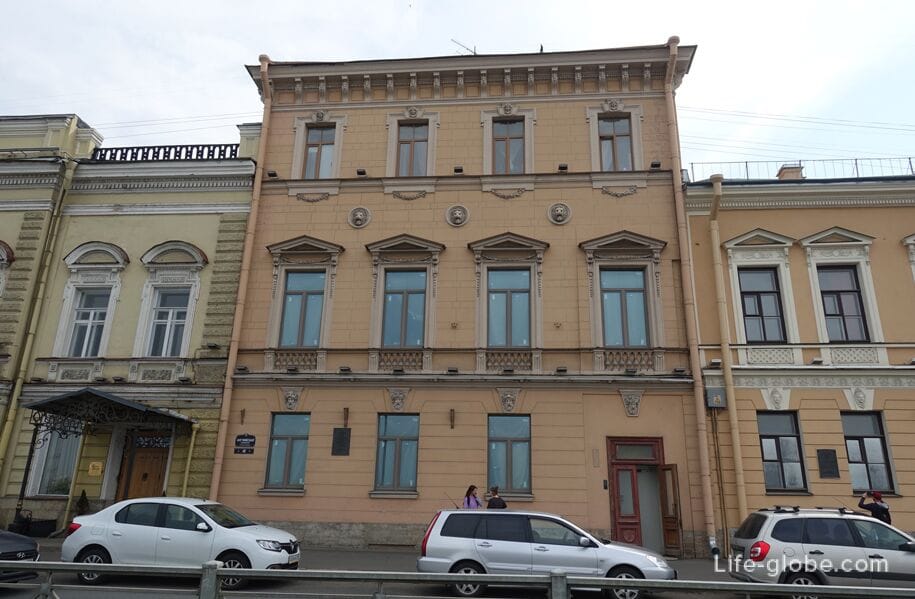
Angliyskaya Embankment 50 - Kapnist's house / Stenbock-Fermor house.
The building was built in the first third of the 18th century and rebuilt in the 1830s.
The building is distinguished by the protruding central part of the facade with a balcony and a pediment. It also has some architectural decorations.
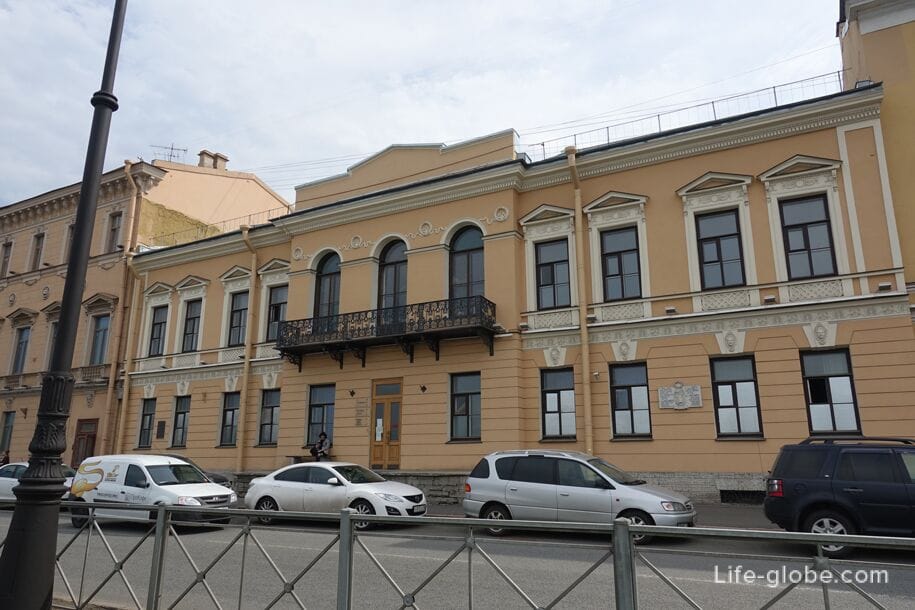
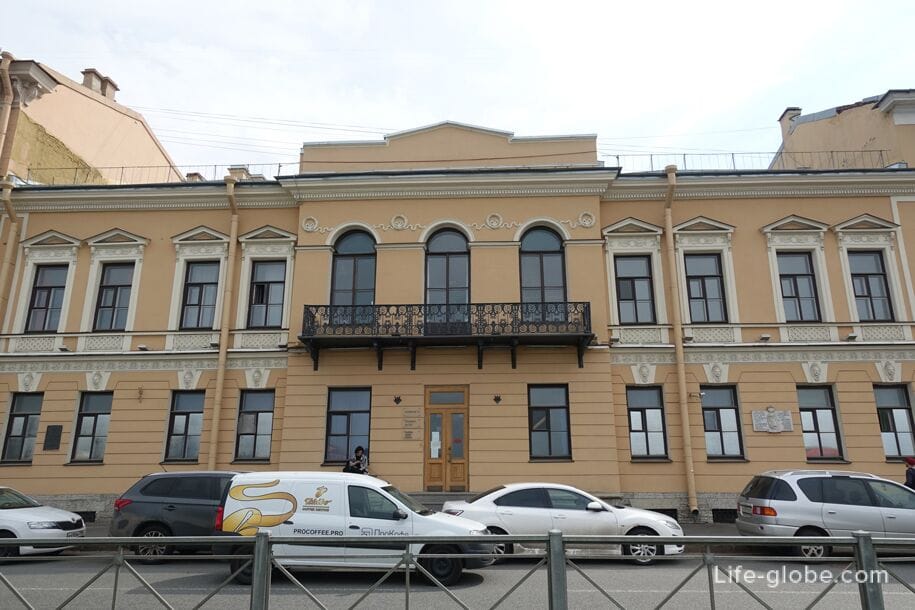
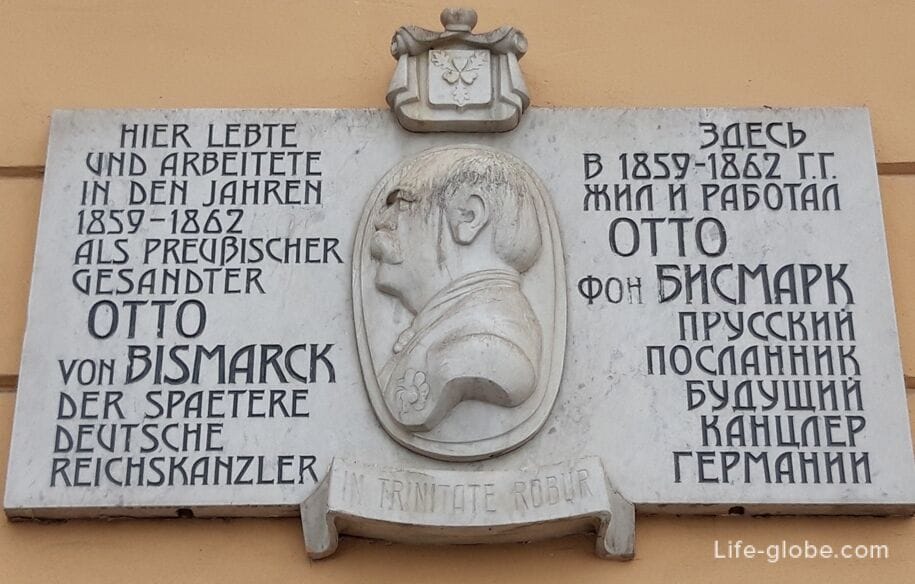
English embankment 52 - house of A.M. Golovin / house of O.K. Briskorn / house of the Strukovs / house of the Potemkins.
The building was built in the 1730s and rebuilt in the early 19th century.
In March 1832, Pushkin began the poem "Yezersky"in this house. The poem remained unfinished, and a number of its elements passed into the work "The Bronze Horseman".
In 1887-1888, the famous traveler and ethnographer N.N. Miklukho-Maklay lived in this house.
The style of the building is classicism.
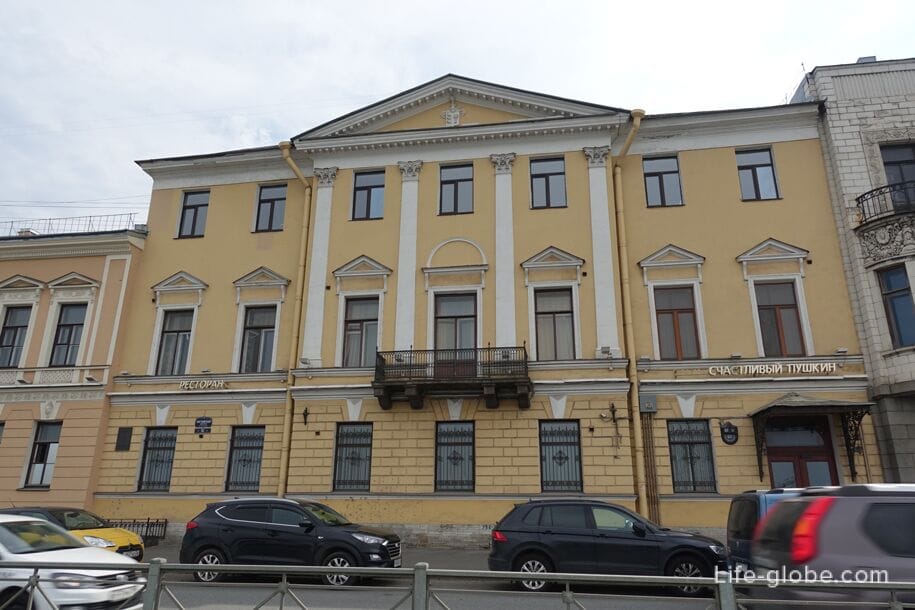
54 Angliyskaya Embankment - the palace of Grand Duke Mikhail Alexandrovich (brother of Emperor Nicholas II).
The palace is an architectural monument of the 18th century. The facade is faced with granite and light ceramic tiles, the lower floor is rusticated. It has two bay windows and three balconies. The bay windows are decorated with reliefs with classical motifs (garlands, masks, torches). The door of the central balcony also has decorations.
Excursions are conducted around the former palace. Read more about the Mikhail Alexandrovich Palace…
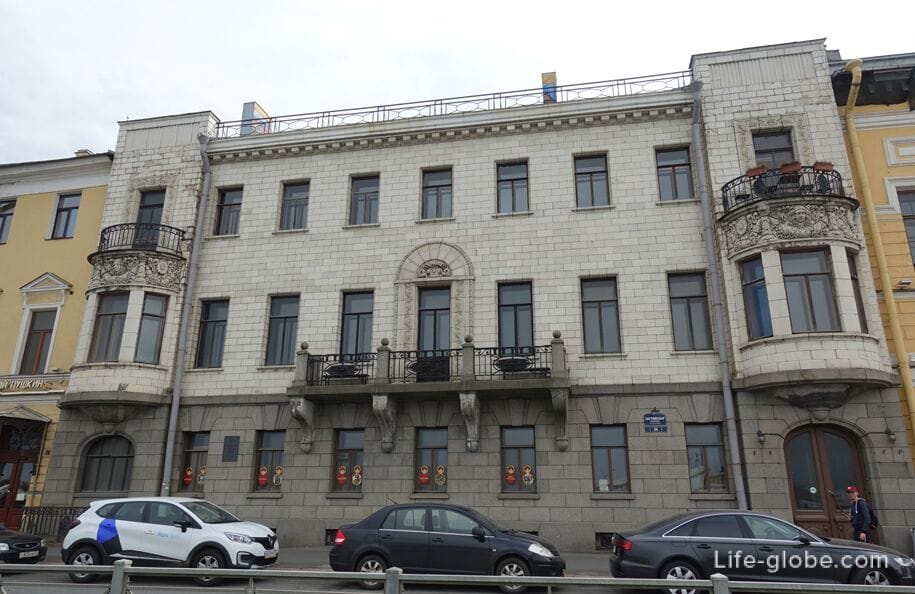
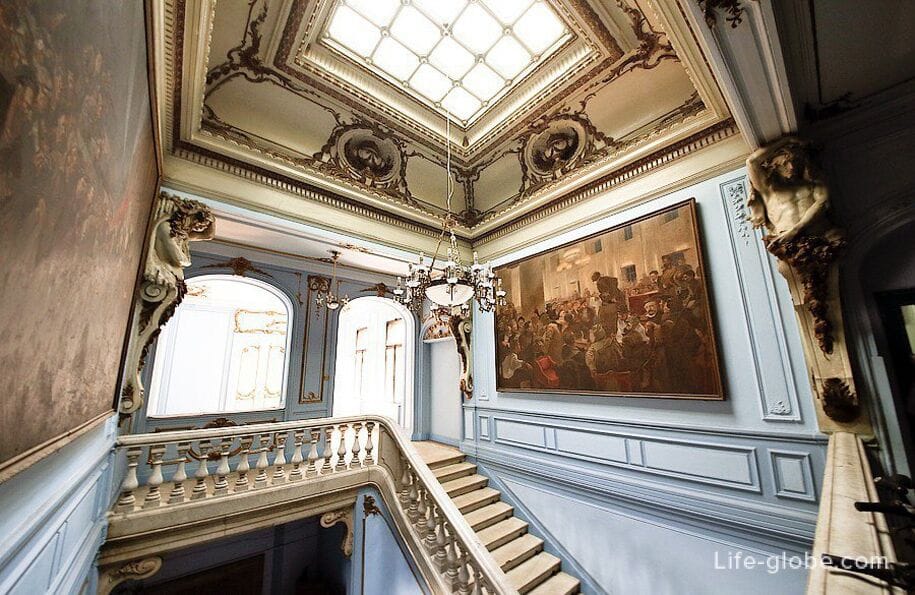
56 English Embankment - The Anglican Church of Jesus Christ (now defunct).
The church building was rebuilt from the mansion of P.B. Sheremetev in 1814-1815 by the architect Giacomo Quarenghi. In 1876, the building was once again rebuilt according to the project of F.K. Boltenhagen. From 1723 to 1919, the Church of England community in St. Petersburg was located in the walls of the building/Petrograd.
The church was closed in 1919. The temple interior (including the only English romantic organ of the 19th century in Russia) is well preserved.
In 2017, the building was transferred to the Music Hall.
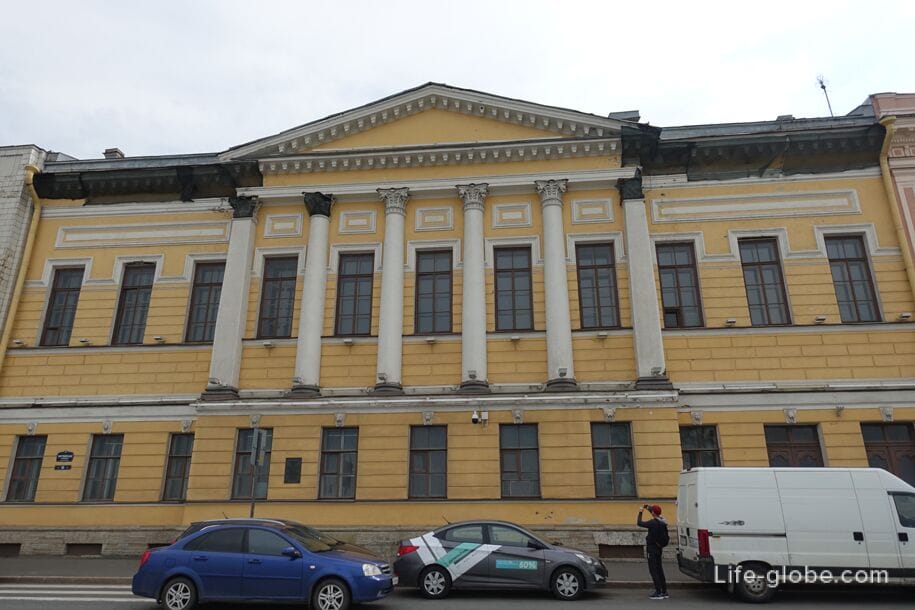
English embankment 58-the house of E. Zanadeorova.
The building was built in the first third of the 18th century and rebuilt in 1858 by the architect Yu. O. Dyutel.
Today, within the walls of the historic building, the English Guest House is located with free Wi-Fi, free parking and family rooms.
The rooms are equippedwith a wardrobe, a flat-screen TV and a private bathroom. Link to the guest house
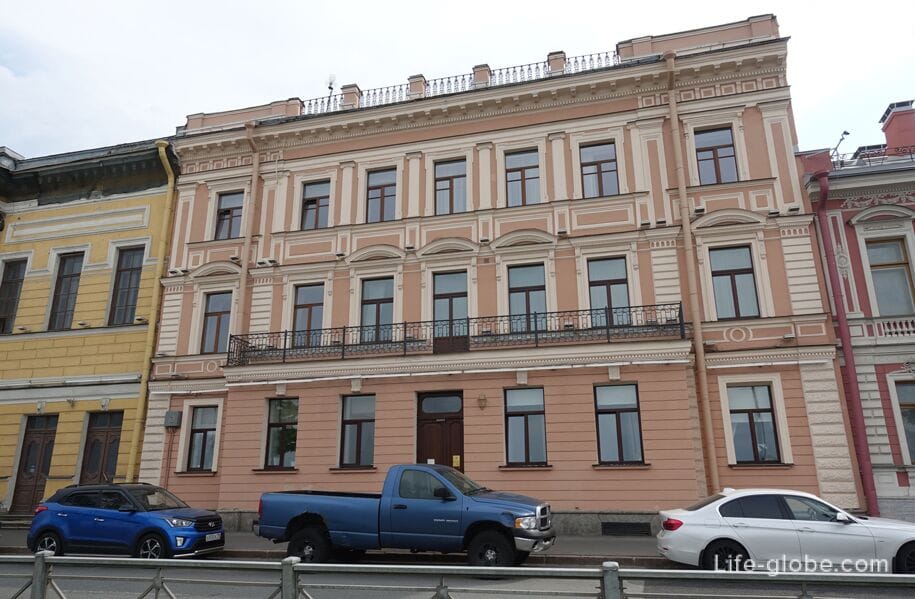
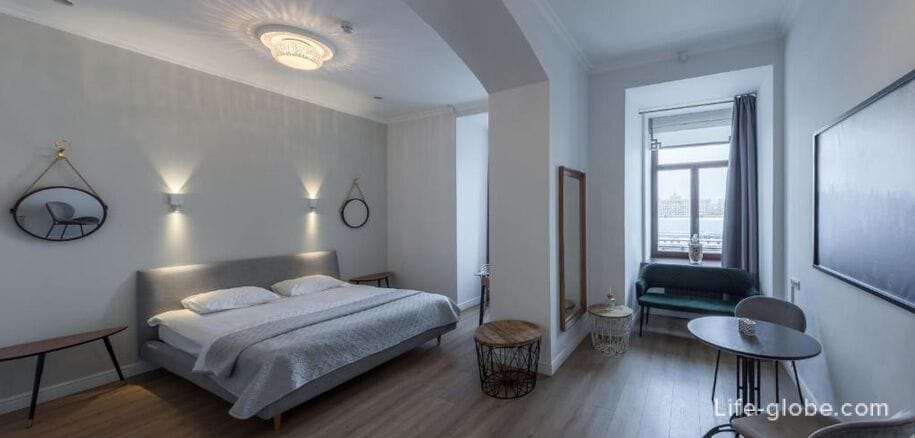
English embankment 60 - the mansion of N.N. Teplov.
The building was built in the first third of the 18th century and rebuilt in 1870 by the architect Pavel Petrovich Mizhuev.
This is one of the most beautiful small buildings on the English embankment. It stands out with a protruding facade, a pediment and an abundance of decorative finishes.
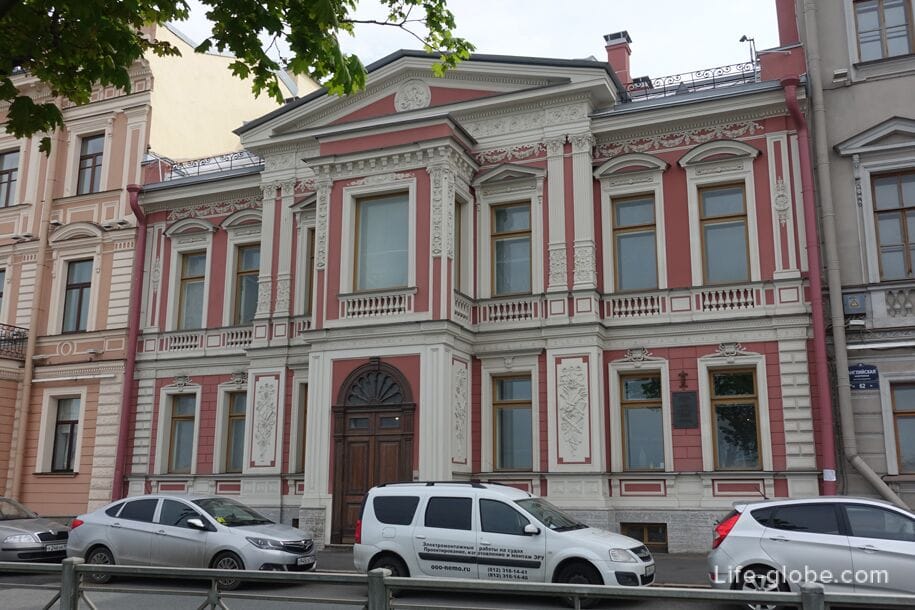
Englishskaya Embankment 62-the mansion of M.N. Chelishchev / the house of I.L. and I.L. Varshavsky / the house of Ya.S. Polyakov.
The house was built in the 18th century. It was rebuilt in 1858 by the architect Nikolai Vasilyevich Trusov and in 1908 by the civil engineer Maxim Yulyevich Kapelinsky.
The building is distinguished by long balconies with openwork grilles at the level of the second and third floors, as well as a few decorative decorations on the facade.
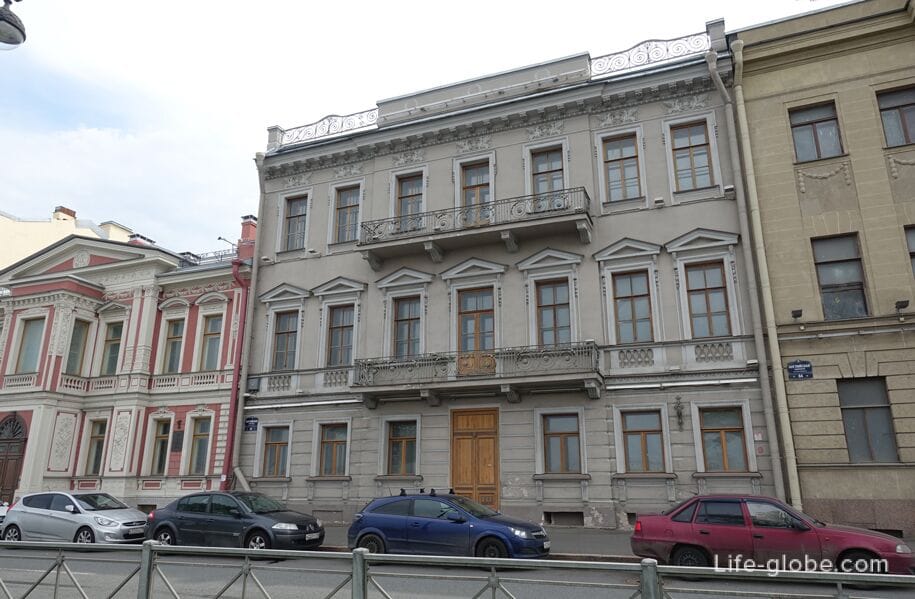
64 English Embankment - the mansion of P. Betling.
From 1913 to 1936, the building housed the Swedish Embassy.
The style of the building is neoclassicism.
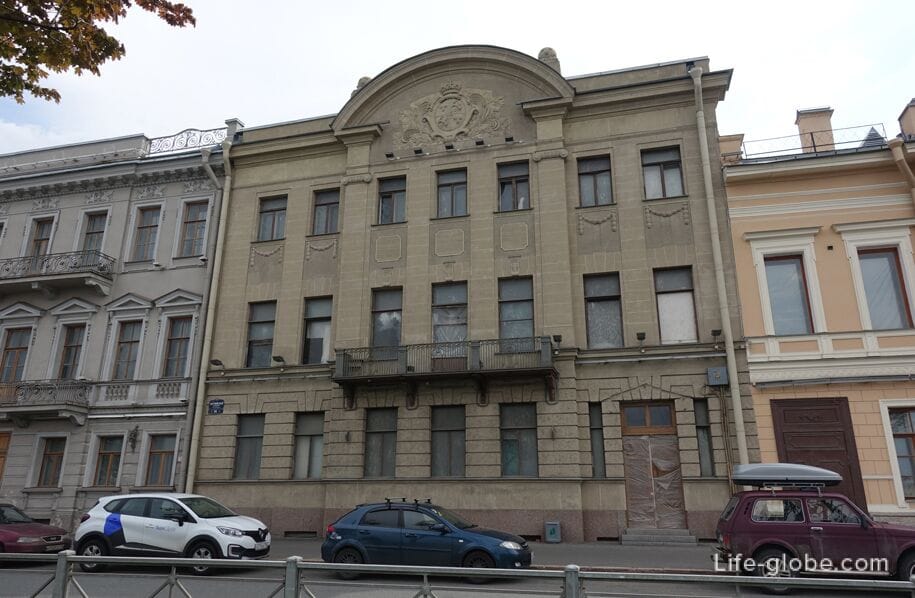
66 English Embankment - the mansion of Prince L. D. Vyazemsky.
The building was built in the first third of the 18th century and rebuilt in 1875 by architects P. G. Mizhuev and L. F. Boulieri.
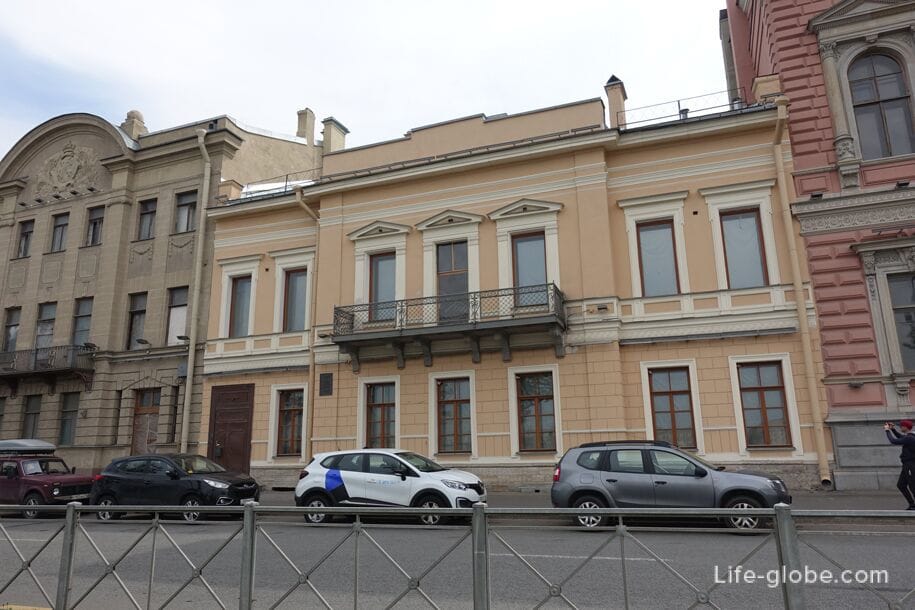
68 Angliyskaya Embankment-the mansion of Baron Stieglitz / the palace of Grand Duke Pavel Alexandrovich (son of Alexander II).
The building's style is neo-Renaissance.
The building has two floors. The facade is made bright and lively, but not overloaded with decorations.
In the center of the facade there is a small two-column portico, above which there is a balcony. The wide frieze of the building is decorated with decorative molding.
Guided tours are conducted around the former mansion. More about the Stieglitz mansion-Palace…

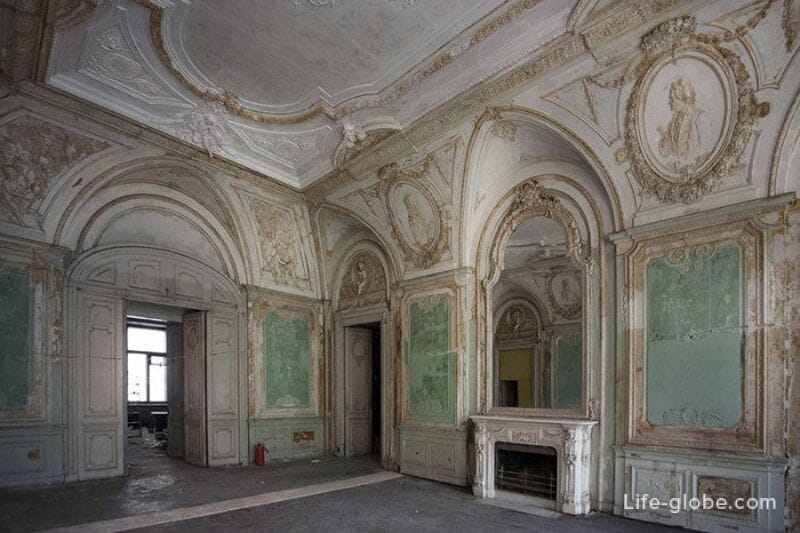
Angliyskaya Embankment 70 - the mansion of S.V. Gweyer.
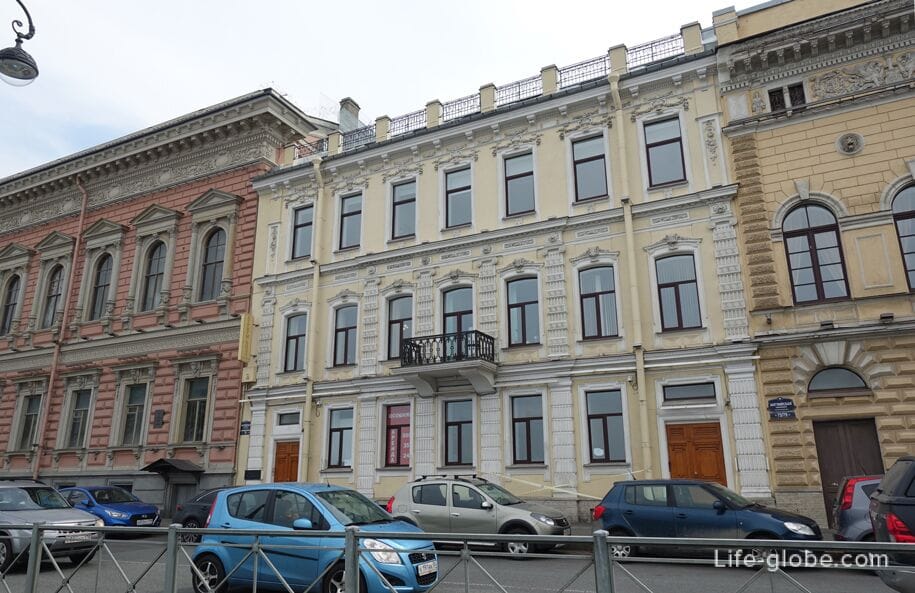
Englishskaya embankment 72-the house of A.F. Rahl / the mansion of E.F. Molvo.
The building's style is neo-Renaissance.
The first floor of the building is decorated with square, the second-with plank rustication. On the first floor, the central risalit is framed by Corinthian pilasters and marked by a window Ionic portico and a large balcony. Above the semicircular windows there are tondo with mascarons of lions. A bas-relief frieze of griffins and floral ornaments stretches above. The facade is completed by a remote ornamented cornice on consoles and a low attic.
Today, the historic mansion is located Molvo Mansion Hotel with free Wi-Fi and free private parking.
There is a fully equipped private bathroom with a bath and a hairdryer. Link to the hotel
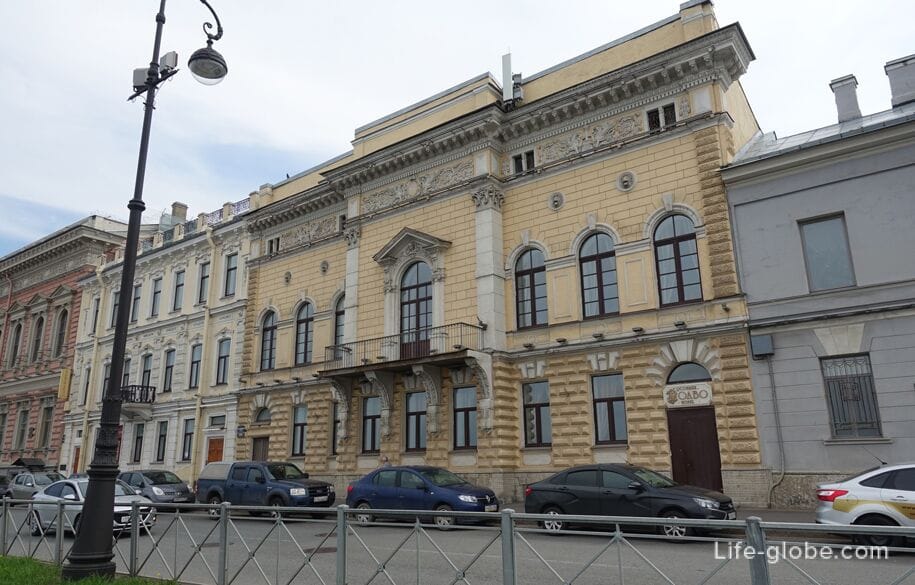
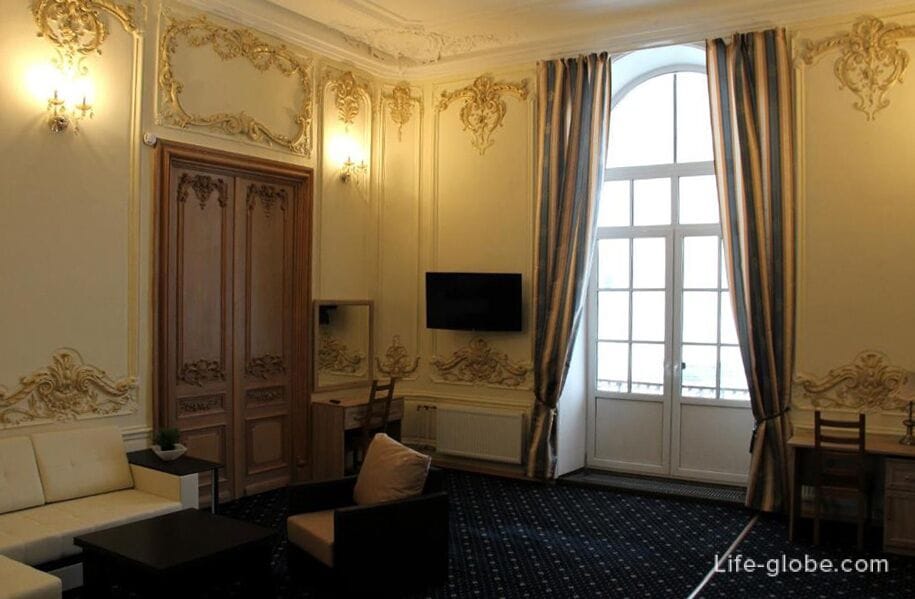
Englishskaya embankment 74 - N.A. Demidov's house / Ya.V. Willie's house / A.F. Gaush's house.
This two-story house of Demidov was marked on the city plans already by 1737. By 1799, the building was somewhat modified, and in the 1820s it was rebuilt.
The style of the building is classicism.
This house closes the buildings on the English Embankment and is a corner house, also facing the embankment of the Novo-Admiralty Canal.
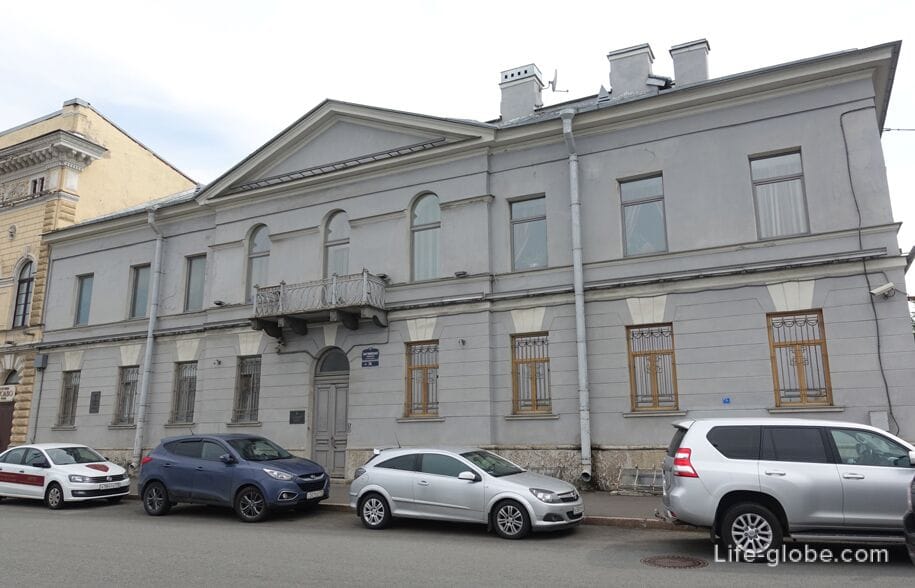
Practical information
Nearest metro stations: "Admiralteiskaya", "Nevsky Prospekt", "Sennaya Ploshchad", "Sadovaya" and "Spasskaya".
All accommodation facilities in St. Petersburg, including in the city center, near the English Embankment and more remotely from those, can be viewed and booked here




